I am happy to report that Batumi was an anomaly – the rest of Georgia is wonderful and quite the adventure when self-driving. I won’t go into the specifics of Georgian driving habits again, you can find those in our previous post, but will share the rental agent’s reaction when we returned the car. Speed is monitored by CCTV, with tickets sent immediately by SMS/text to the registered owner. The agent was dumbfounded that we had not received a single ticket (he was fairly confident that had never happened before with a long-term rental), and commented that Howard must be “very good driver.”

I knew very little about Georgian history beyond being the birthplace of Stalin, and loved delving into it. I’ll just share a few of the highlights with you – honestly, it’s only a few!
Ancient Greek sources referred to the tribes skirting this part of the Black Sea as the Colchis, and according to their mythology it was from the king of the Colchis that Jason and the Argonauts stole the Golden Fleece. The tribes further inland were known as Iberians, which some scholars believe was how the Greeks referred to the furthest reaches of their known world: modern-day Portugal and Spain was the Iberian Peninsula; the South Caucasus region was the Kingdom of Iberia. Between the 6th and 1st centuries BCE, the Persians controlled bits and pieces of the Caucasus region, and the name Georgia is believed to be a derivative of gorğān, an old Persian word meaning land of the wolves. The native people referred to themselves as Kartveli. With the dawning of the Common Era, the Romans were busy expanding their reach into the southeastern extremities of Europe, and the kingdoms of Colchis and Iberia (Romanized jointly as Sakartvelo), were added to their empire. How “Georgia” entered the history books as the prevailing name is unclear.
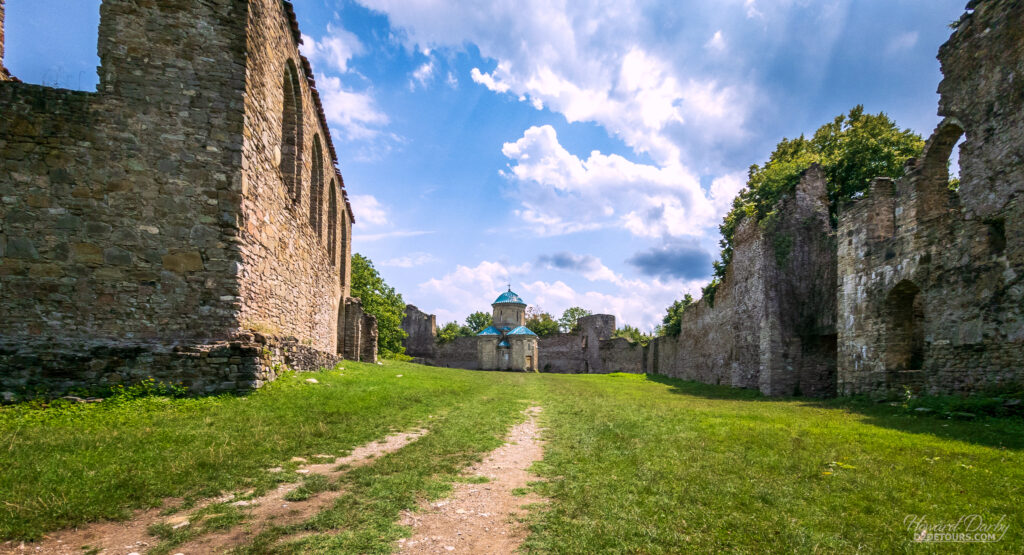
Under Roman rule, Christianity was introduced to the populous, and in 327 CE was declared the state religion. Nominally a Roman province, in reality Sakartvelo was a loose collection of feudal estates bound together by a deeply ingrained Christian faith, which by the 9th century was Eastern Orthodoxy. In the 7th century, this solidarity kept Islam from taking root despite being fully embraced by Georgia’s closest neighbours. At the beginning of the 11th century, these feudal estates had coalesced into a bona fide kingdom, the Kingdom of Georgia with the Bagrationi family wearing the crown. This kingdom prospered over the next 450 years, but like many close-knit loving families various branches of the bloodline wanted a bigger piece of the pie. In 1463, the kingdom fractured into three smaller realms: Kartli, Kakheti, and Imereti, all of which, weakened by Mongol invasions and bubonic plague, would become vassal states of the Ottoman Empire in the 16th and 17th centuries.
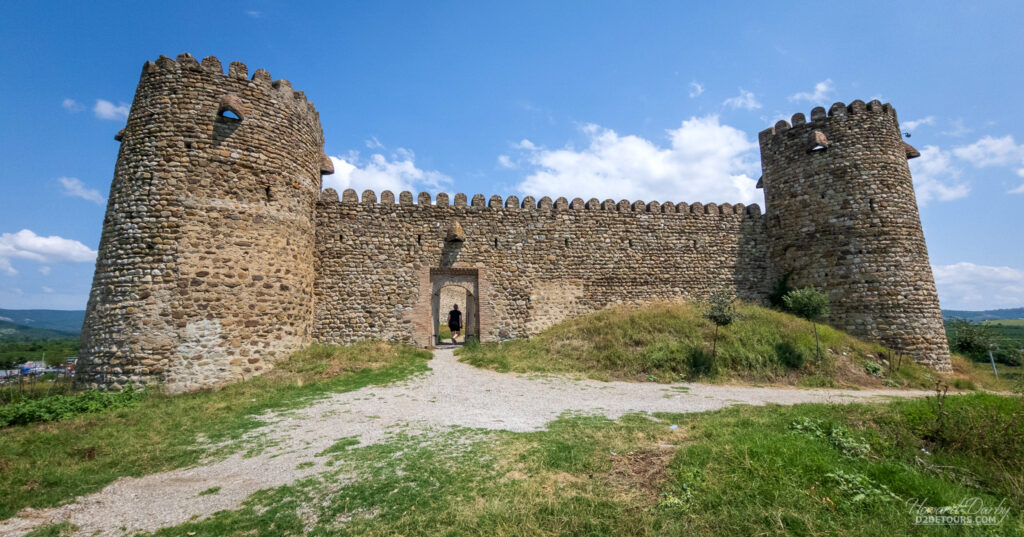
Interestingly, under Ottoman law as long as a vassal state declared their loyalty, met their annual tribute obligations, and paid a non-Muslim tax, the Turks ignored them, allowing life to continue as before, including freedom of religion. Members of the Bagrationi family would continue to be the figureheads for these Georgian vassal states until the 19th century when civil wars throughout the vast Ottoman empire, coupled with foreign invasions, were taxing the Turks’ resources. Persia (Iran) had its eyes on reclaiming Georgia. The king of the northern Kartli/Kakheti kingdom saw an opportunity for independence and approached Russia for assistance, which it happily offered. Regrettably, some backdoor hedging of bets left the Georgians backing the wrong horse. The Russians withdrew, and the Persians seized control of that region.
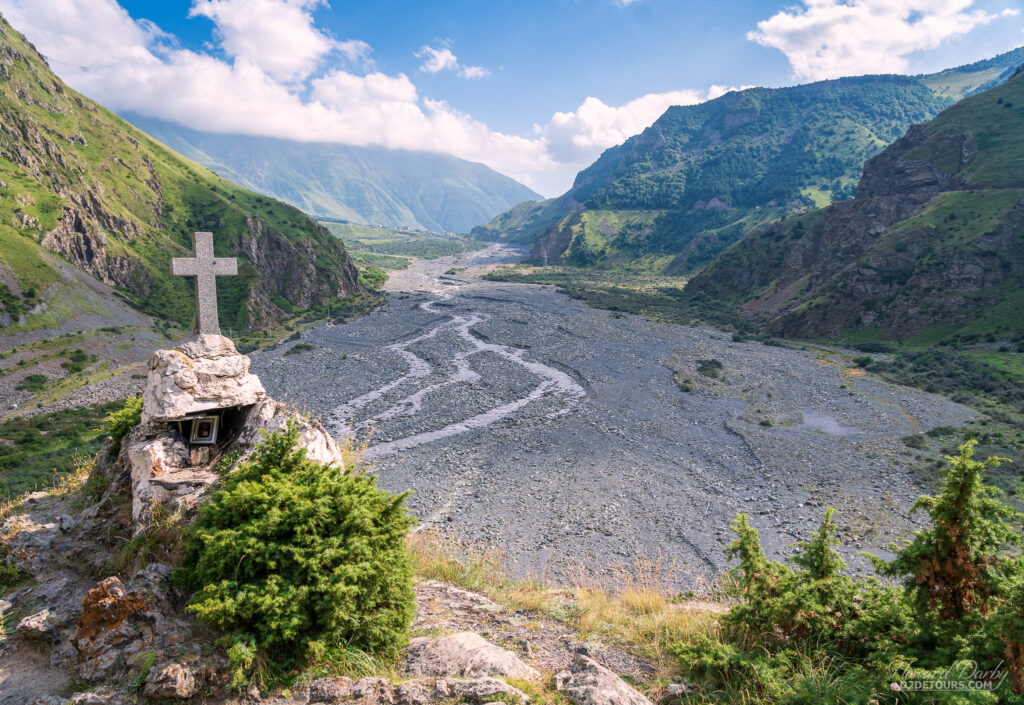
It didn’t take long before the Kartli/Kakheti kingdom was embroiled in its own civil war, and one of the players again turned to the Russians. This time Russia took the “fool me once” approach. It agreed to lend support and simply annexed the land into its empire. Over the next ten years, the Russians brokered a variety of peace treaties with the Ottomans and Persians, snatching up the bits of Georgian territory still controlled by those empires. The Bagrationi dynasty was done. Georgia’s history at this point follows a similar refrain. It was part of the Russian Empire until 1918, when it witnessed a flicker of independence, and then the Bolsheviks invaded in 1921 and it would spend the next 90 years as a member state of the USSR. Despite the Soviet Union not being formally dissolved until December 26, 1991, Georgia had previously declared its independence in April, holding their first presidential election with an 83% voter turnout. Post-Soviet Union Georgia has not been all sunshine and roses. Violent civil war and revolution plagued the country well into the 21st century, and there are still two disputed territories along its border with Russia. Their pro-western stance has not endeared them to that northern neighbour. In March 2022, following the Russian invasion of Ukraine, Georgia formally submitted its application for membership in the EU, and was granted candidate status in December 2023. There are many, many hurdles to overcome before it will gain full accession.
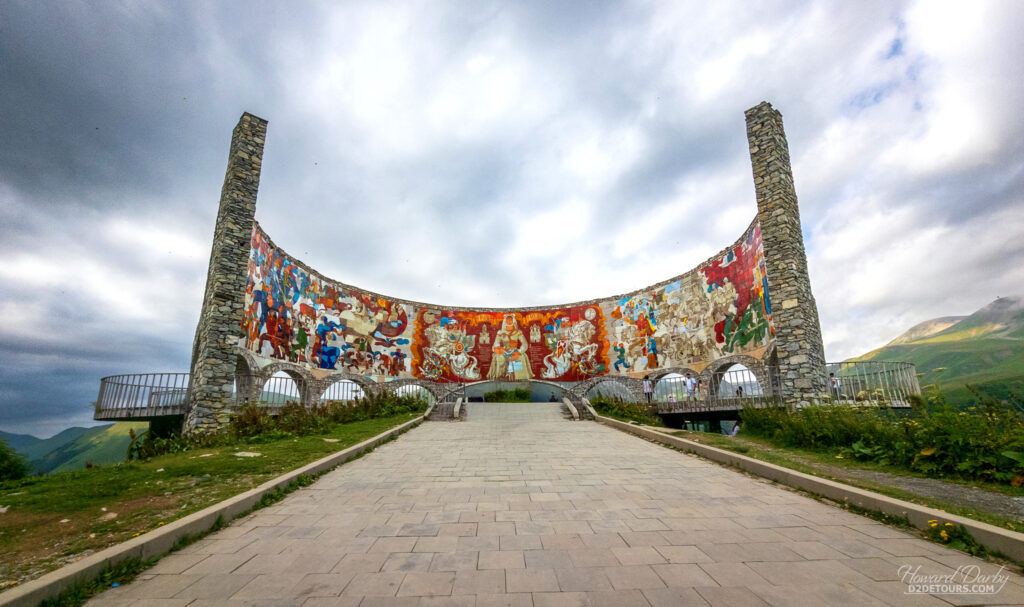
Dollars – While we didn’t feel Batumi was a bargain, the rest of Georgia was.
| Cost/Day (2 people/29 nights) |
What’s Included? | |
|---|---|---|
| Basic living expenses | $124/day Canadian ($92 USD / €83) |
Car rental, gas, accommodation, sightseeing/entertainment, groceries, wine, and restaurants |
| All-inclusive nomadic expenses | $137/day Canadian ($102 USD / €92) |
Basic expenses above plus health insurance, data packages, and subscriptions (Netflix and other streaming services, website hosting, Adobe Lightroom, VPN, misc apps, etc.) |

Environment – Our impression was that most people visit Sighnaghi (Sing-yaw-hee) as a day trip from Tbilisi, and that may have accounted for the attractive price of accommodation as B&Bs try to entice people into a longer stay. We spent four nights in the Guest House Mtisubani, just outside the old city walls with a lovely terrace overlooking the valley. The nightly rate was $42.50 CAD /$31.50 USD, including an amazing breakfast – sausages, eggs, bread, cheese, and fruit. This mid-morning meal was so satisfying we didn’t need much else for the rest of the day, and were quite content with some light snacking (and a glass of wine) each evening out on the terrace, watching twilight creep into the valley.
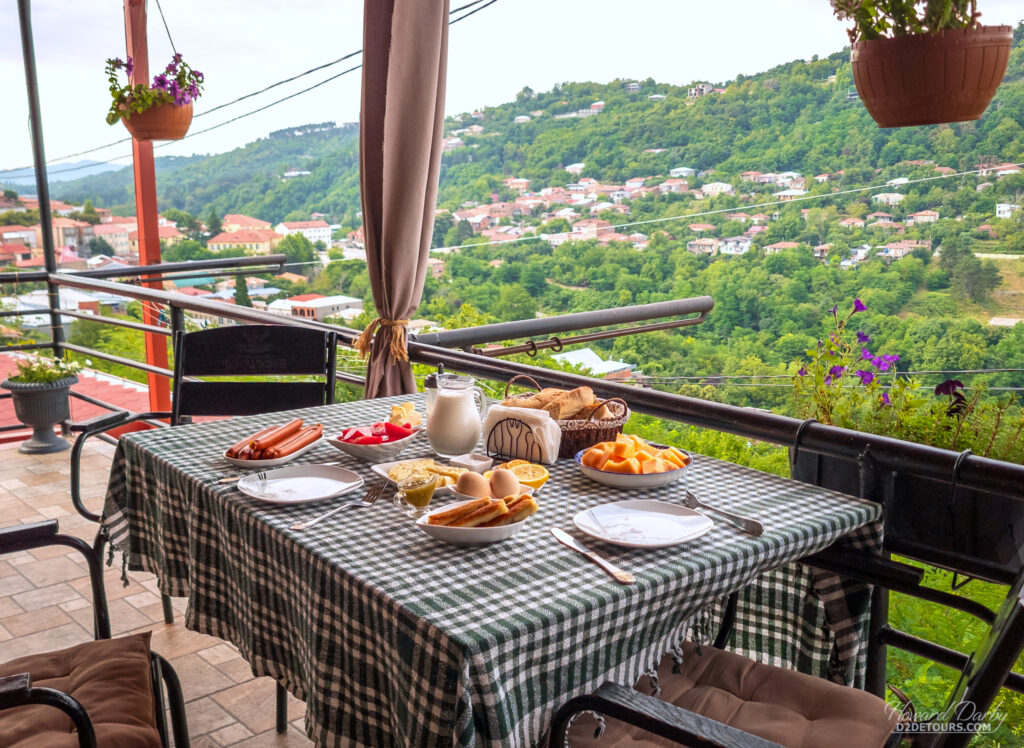
Stepantsminda is only 11 km / 6.8 miles from the Russian border and does have a bit of a “Bordertown” feel to it. It is also a gateway to some spectacular mountain hiking and about an hour north of the ski resort town of Gudauri, all of which may have contributed to its higher price tag. At just under $71 CAD/night ($52.50 USD), it was the most expensive place we stayed in all of Georgia. Fortunately, we were very pleased with the Devdaraki Apartments, and enjoyed four nights in a relatively new building with modern finishes – we just had to dodge cow patties to get inside.

We spent 14 nights in Kutaisi (Koo-tie-cee), which probably sounds like a long time. Having arrived in Vienna in mid-April, by July we had nearly maxed out our allowable days in the Schengen Zone. As non-EU residents we can only be in the Zone, which is composed of 29 European countries, for 90 out of every 180 days. Our plan this year has us back in the Zone in October ,so we needed to find somewhere to spend 90 days between July and October. Georgia was perfect for a chunk of that time, and Kutaisi was well situated for some daytripping. We found a terrific Airbnb in a quiet residential neighbourhood within easy walking distance of the city center. It had a well-equipped kitchen so we could prepare most of our meals at home, and came with an attractive nightly rate, $44 CAD / $33 USD, plus some dreadful homemade wine.
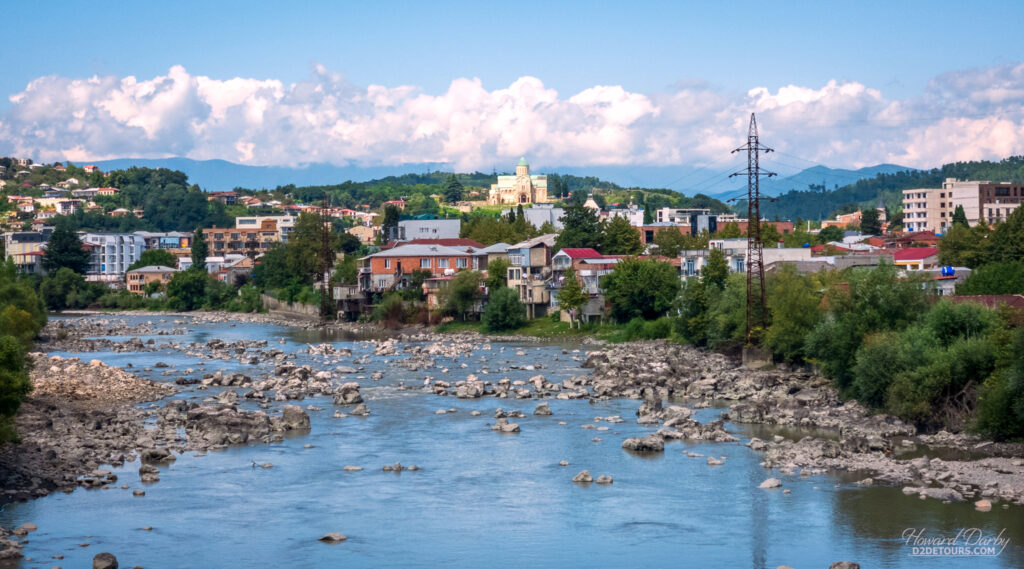
Mestia attracts the backpacking crowd and many of its hotel accommodations are pretty basic. Comfortable enough, the Guesthouse of Manoni Ratiani with just a bed and a bathroom served our needs for three nights, and we couldn’t complain about the price – $33.50 CAD/night ($25 USD).
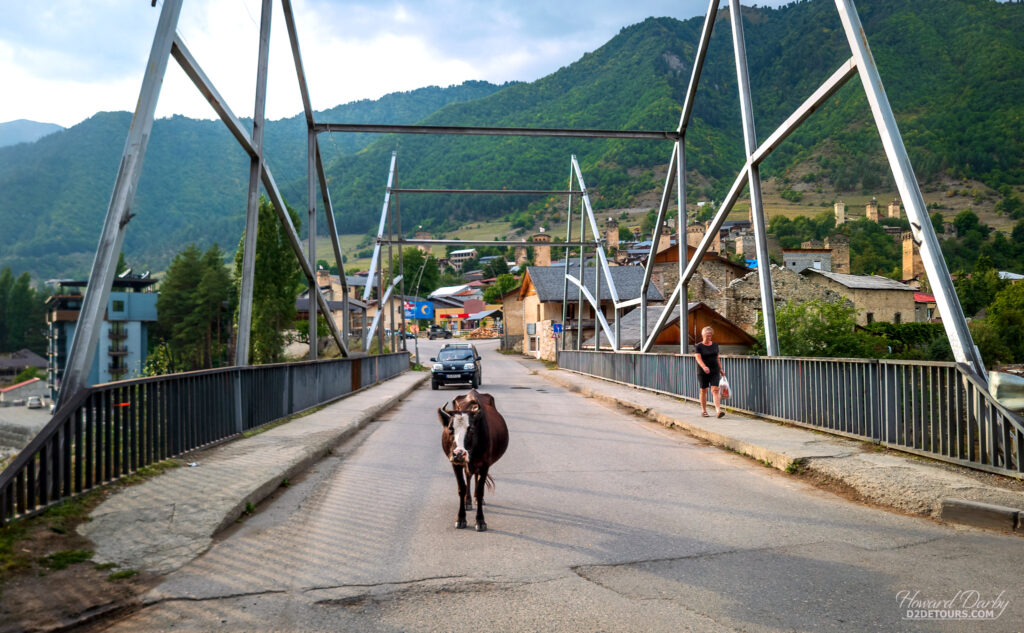
Originally we had planned to head to Vardzia in southern Georgia, but car troubles forced us back to Tbilisi. We broke up the drive from Mestia to Tbilisi with another night in Kutaisi, and lucked into finding great accommodation on such short notice, although we were glad we had a car in both cities. The Kutaisi room was way up in the hills with a spectacular view of the city, but I would not have wanted to reach it on foot, and the Tbilisi Airbnb was on the outskirts of the city.
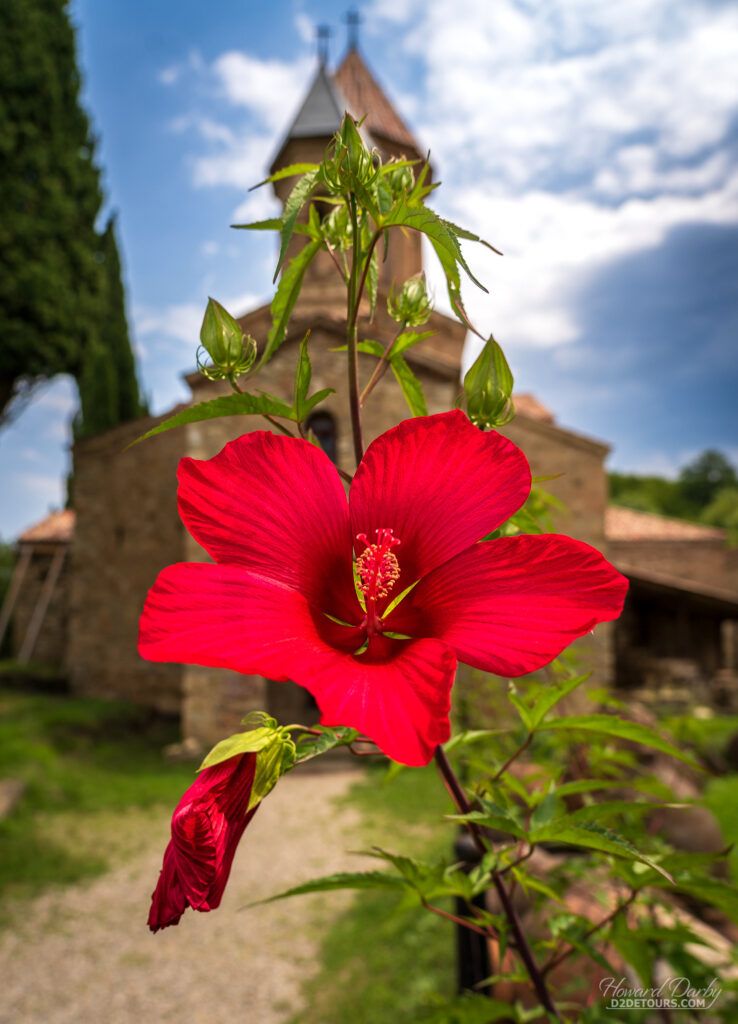
Tips, Tricks & Transportation – We rented a car for this road trip through LocalRent and were very pleased with their service and price. If you didn’t want the excitement of driving yourself around Georgia, there is bus service covering most of the country. We took one from Batumi to Tbilisi (total ticket price for both of us was $41 CAD / $30 USD), and thought the service was great. For us, having a car let us get to more of the off-the-beaten-path sites – always our preference.

Out and About
We picked up our rental car in Tbilisi and headed southeast into Georgian wine country, passing some interesting ruins along the way, one of which was the Ninosminda Cathedral (circa 575 CE), an early blueprint for Georgian cathedral architecture. The fortified complex had undergone numerous restorations over the centuries before earthquakes in the 1800s delivered a devastating blow. Remarkably, some of the early fresco work remains visible.
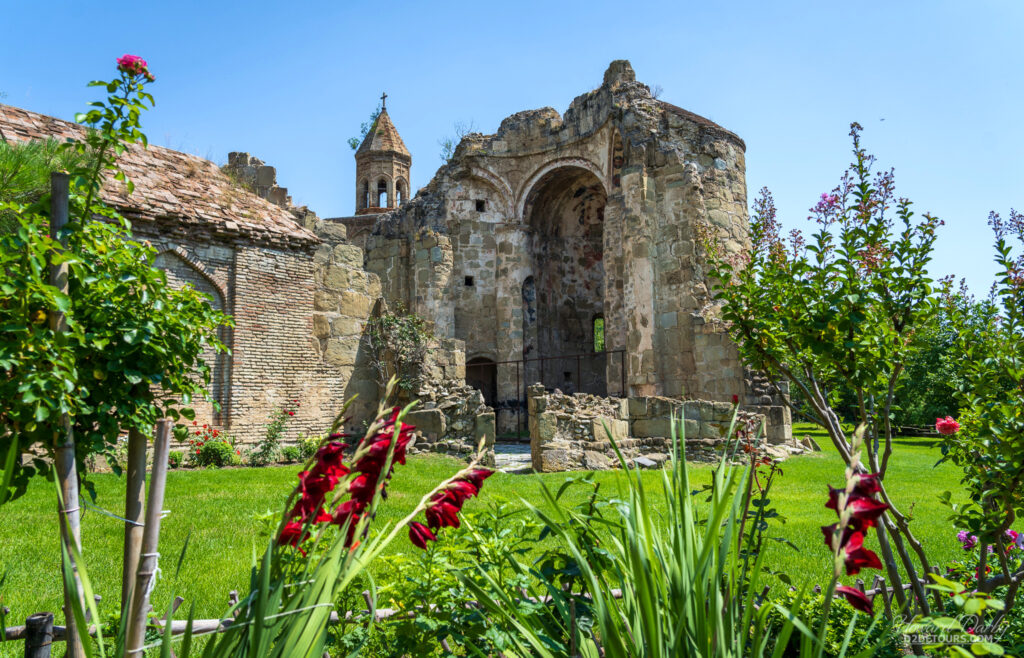
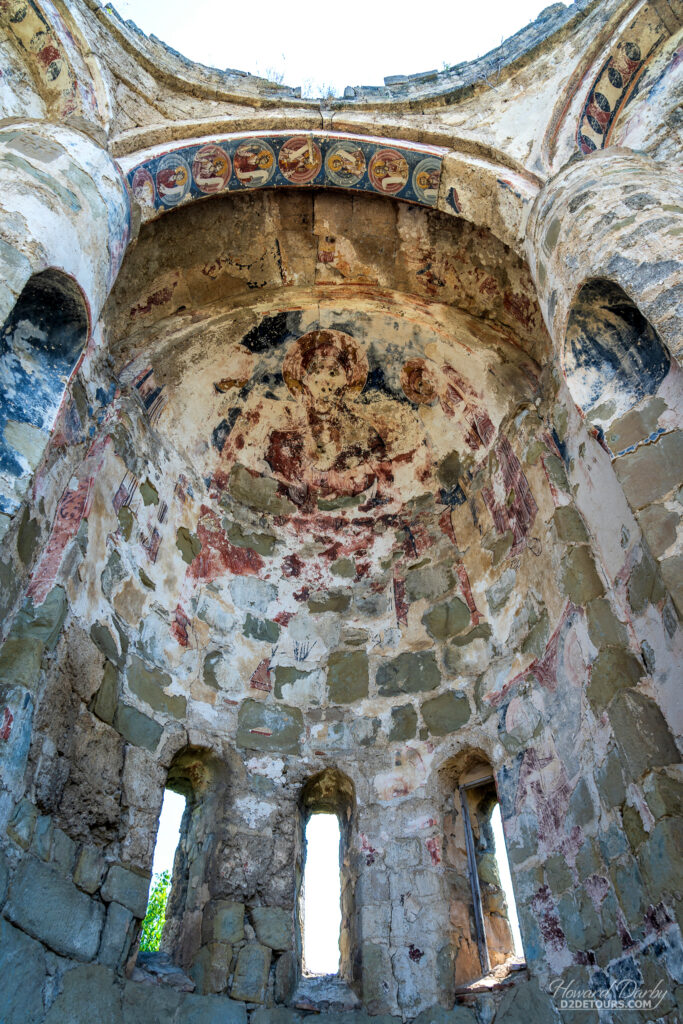
Sighnaghi is a charming town overlooking the Alazani Valley, one of Georgia’s most famous wine-producing regions.

Georgia has recently laid claim to the title “oldest wine-producing region” with the discovery of wine jars dating back 8,000 years! The unique feature of this country’s winemaking method is the use of qvevri/kvevri, a handleless earthenware. The pottery is buried in the ground, or set into the floor of a wine cellar, and is used for fermentation, aging, and storing purposes. Their size varies from 20 litres to 10,000, with 800 litres being typical.
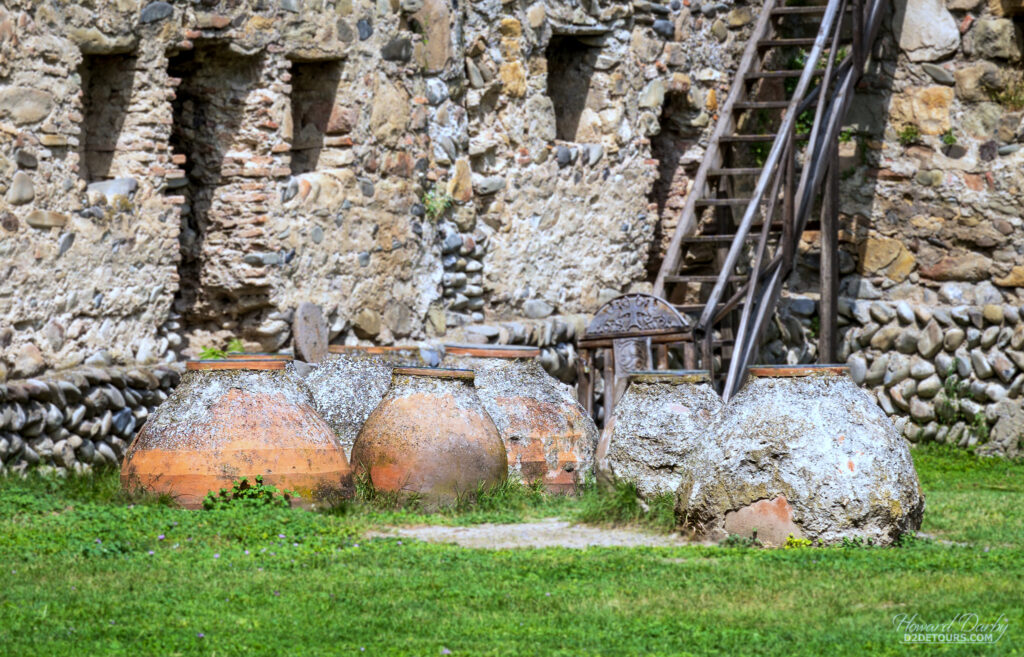
The most popular white grape variety is Rkatsiteli, which when blended with the red Saperavi grape to produce a rosé (and bottled by a winery) was very pleasant. As a homemade white wine, which I sampled on several occasions, it was hard to get past the notes of petrol. Georgian monasteries have a long winemaking history. Within the walls of the 6th century Ikalto Monastery, mastering winemaking technique was just as important for the monks as were the more intellectual pursuits of theology, rhetoric, astronomy, philosophy, etc.

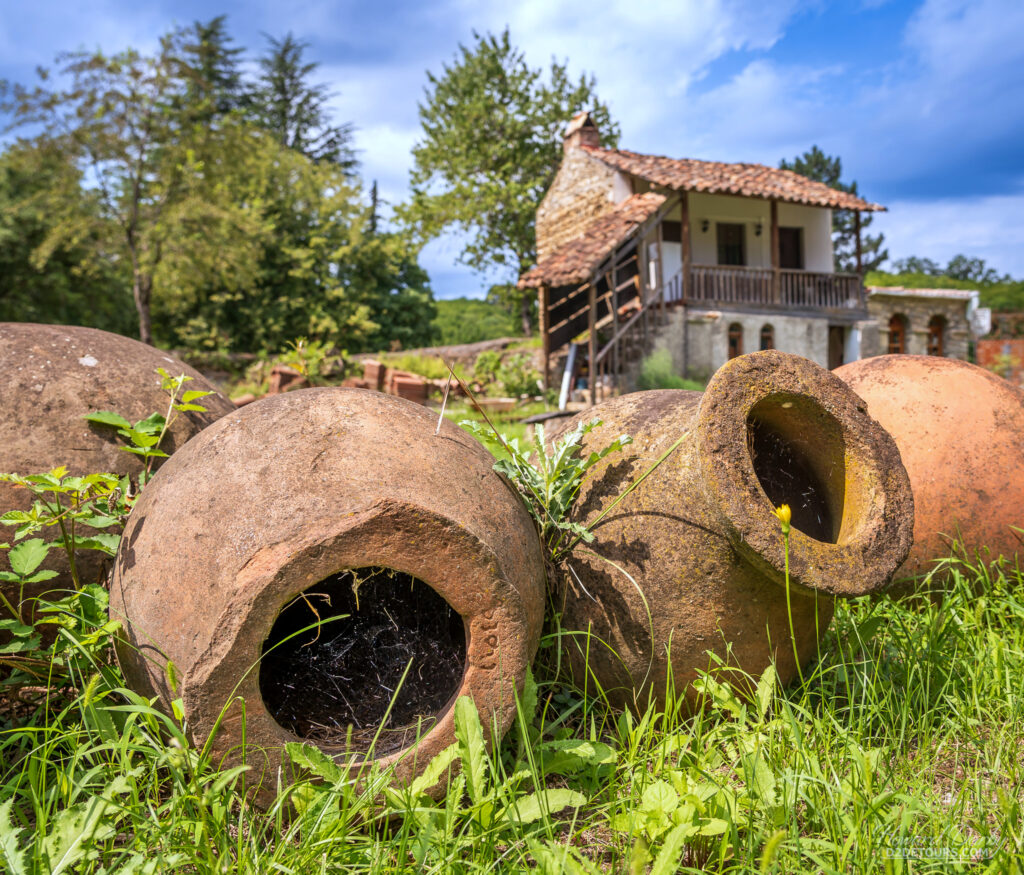
While I found the wine history (and sampling) captivating, Howard was drawn to the Shiraki Military Airfield. It is a 1.5-hour drive east from Sighnaghi and getting pretty darn close to the Azerbaijan border – at several points on the highway there were signs warning drivers not to stray off course. The Soviet government had established an airbase here back in the early 1950s, and it was a key post from which the Russians launched fighter craft during the Soviet-Afghan War (1979-89). Following that war, and the collapse of the Soviet Union, the Russians began removing their aircraft, and by June 1992 all but one had been successfully relocated. The Georgian military never put the airfield to use, yet during the 16-day Russo-Georgian War in August 2008 the Russians directed a sizable portion of their aerial artillery at this abandoned base. Today, local farmers use the land to graze their cattle and have co-opted a few of the 53 hangars as granaries. Howard enjoyed it from a photographer’s perspective, and I thought it was fun to zoom (or at least as fast as a Prius will zoom) down the still intact runway.
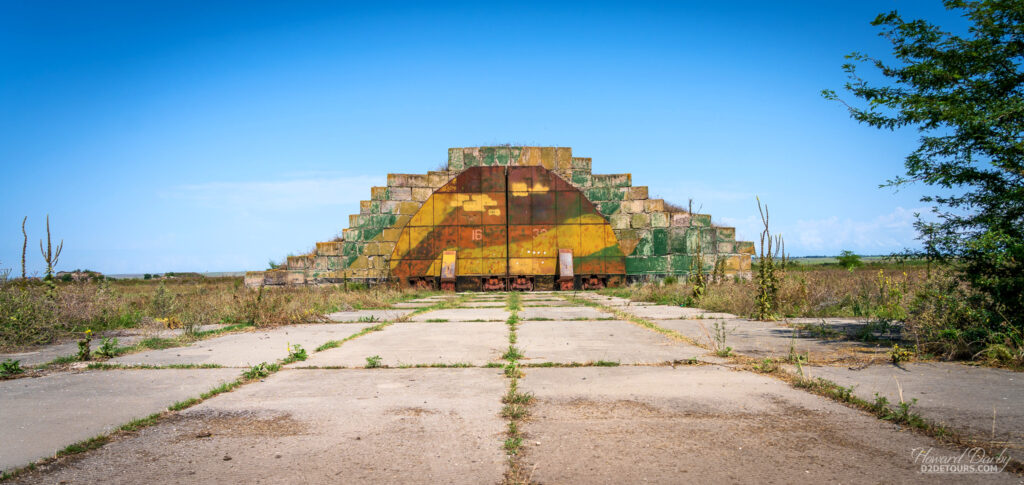
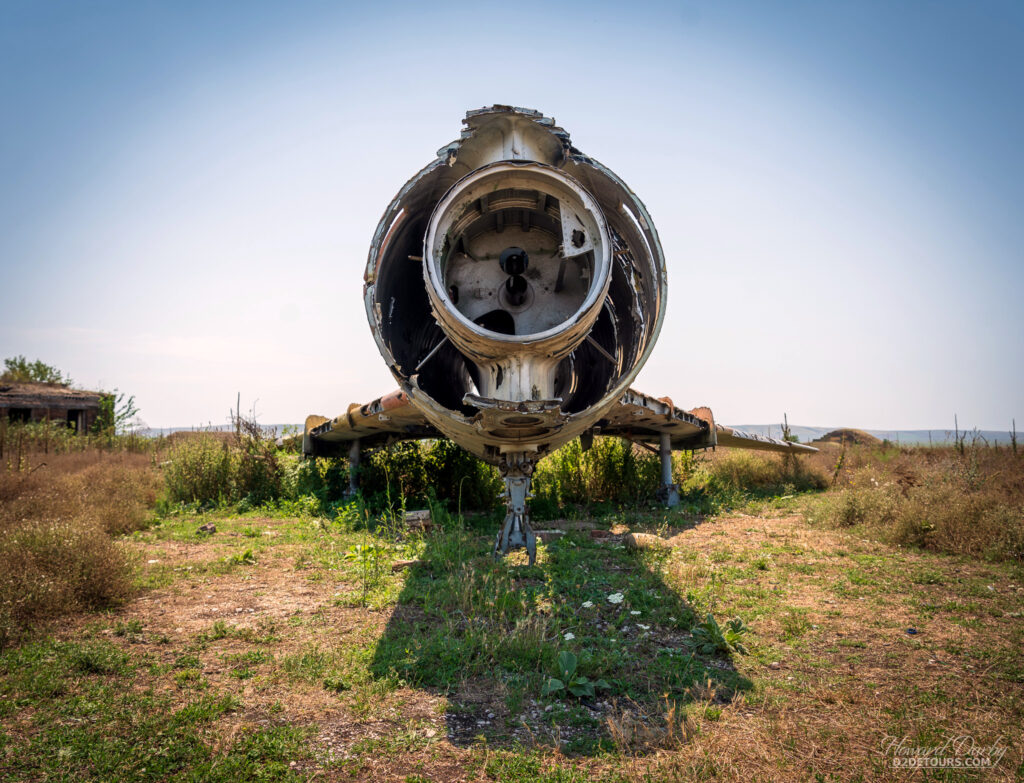
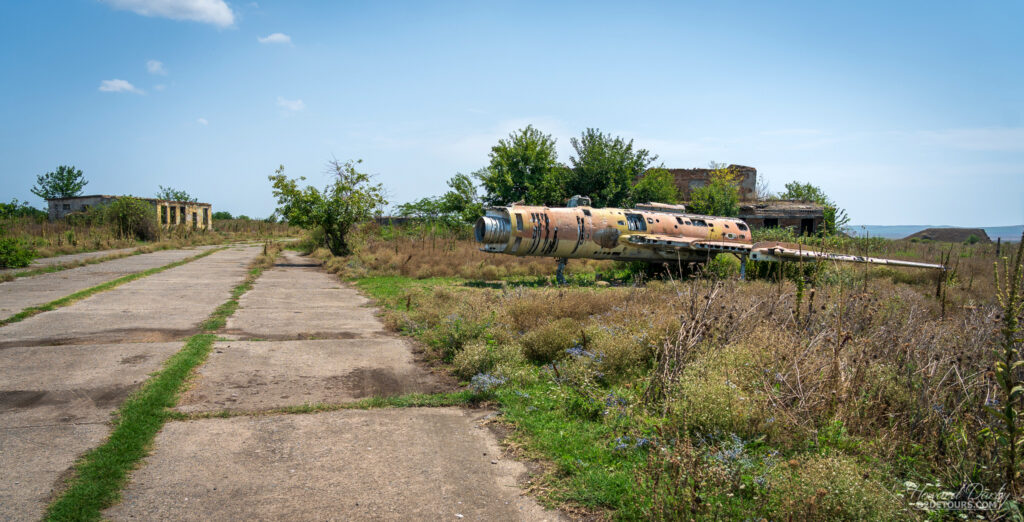
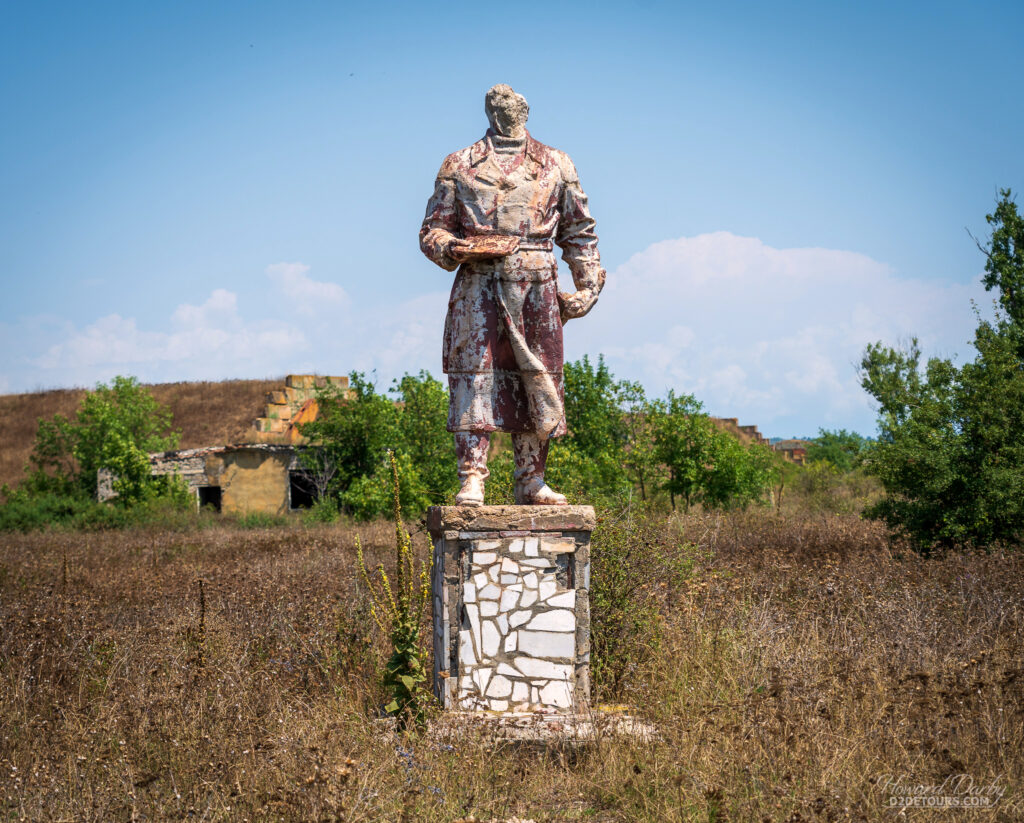
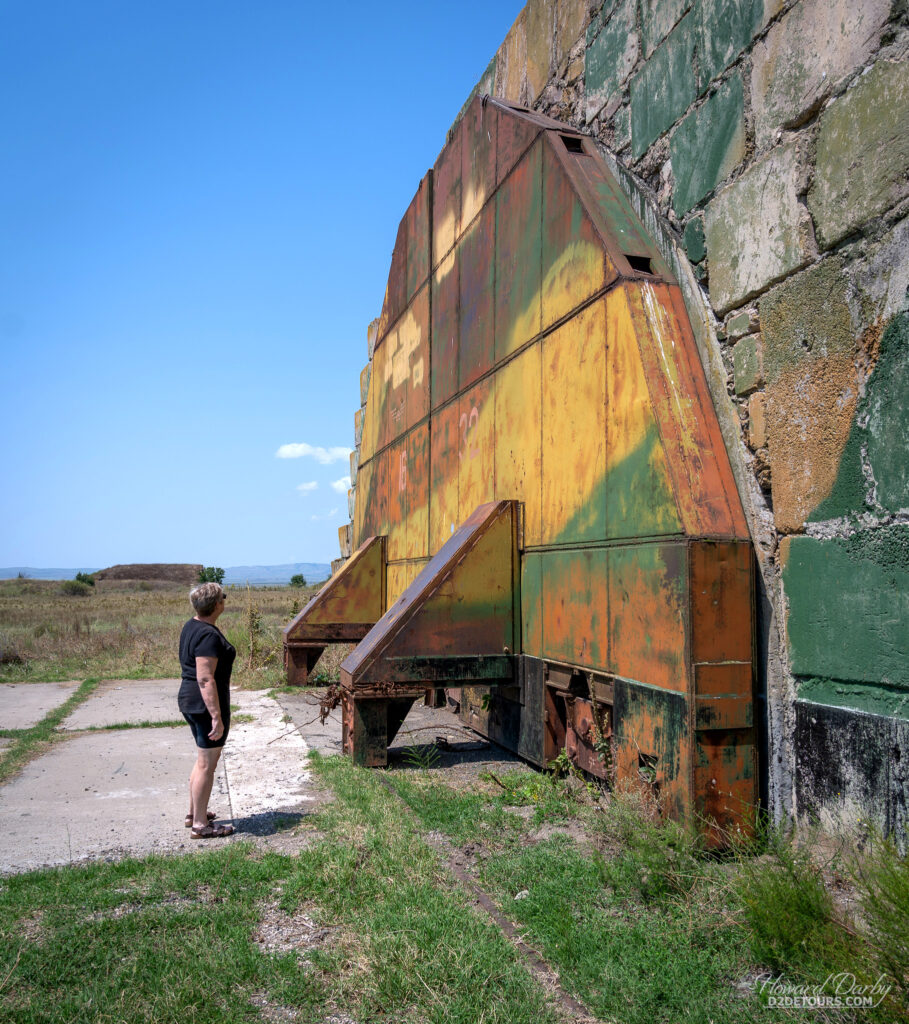
It does not matter where you are in Georgia, within city limits or out in the countryside, you’ll find an Orthodox church within your line of sight, probably more than one. Some are old, some are new but they all adhere to a similar design, except for the Gurjaani Kvelatsminda. Built in the 8th or 9th century, it is the only existing example of a double-domed church in Georgia.
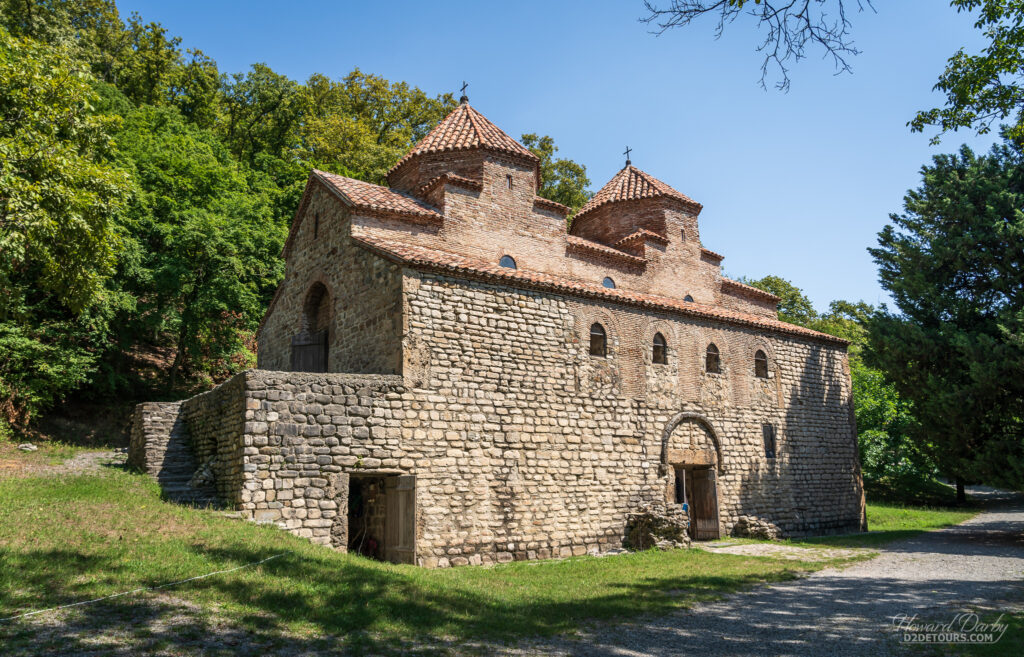
I have become quite accustomed to the modesty requirements in places of worship (shoulders, upper arms, knees, and head covered) but did not realize that covering my knees with either pants or capris was unacceptable in Georgian Orthodoxy; I needed to be in a skirt or dress! Luckily, a basket of wraps was readily available at the entrance to Gurjaani. Enforcement of this particular dress code seemed a bit hit or miss in the various churches and monasteries we visited. We saw women in pants who were asked to tie a wrap around their waist, and in other churches the monks turned a blind eye to female attire. I stuck to wearing a dress. The one I had tailor-made for me earlier this year in Vietnam was perfect.

From southern Georgia we headed north towards the Russian border and the townlet of Stepantsminda. While alpine hiking is the main lure for tourists to this region, the 14th-century Gergeti Trinity Church, perched high above the town in the shadow of Mount Kazbek, draws its fair share of pilgrims too. Given its elevated position and limited access points, the church served as a repository for precious relics whenever medieval Georgia found itself under attack.



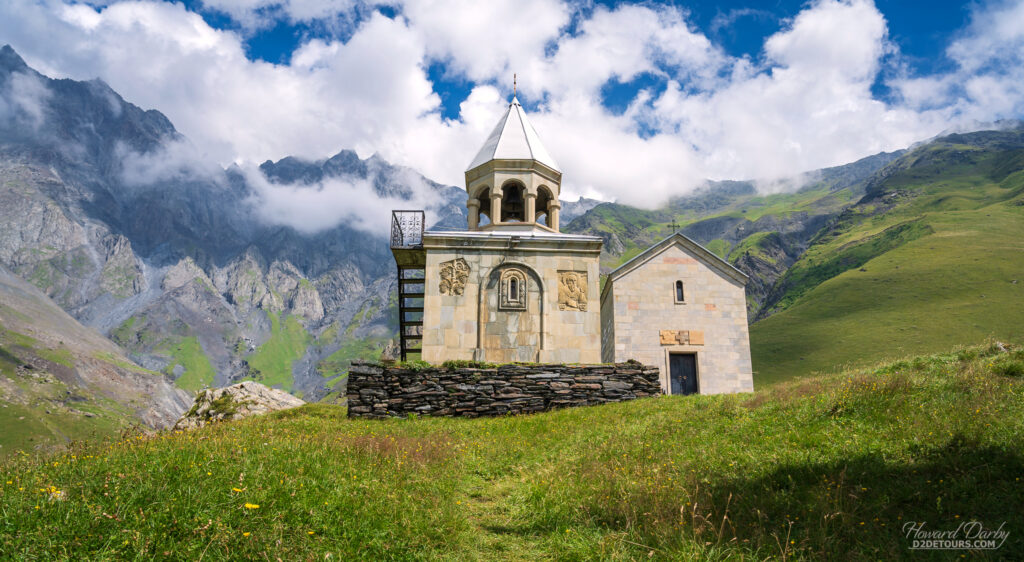
Kutaisi (koo-tie-cee) is an ancient city whose origins can be traced back to the sixth century BCE. During the Middle Ages, it was the capital of the Kingdom of Georgia, and the subsequent Kingdom of Imereti when Georgia splintered into three smaller realms. Within the Russian Empire, it lost its capital city status but its notoriously harsh jail did have the distinction of housing the radical reformer Joseph Stalin before he was exiled to Siberia in 1903. Its most notable landmarks are, not surprisingly, religious in nature. The 11th-century Bagrati Cathedral was a masterpiece of medieval Georgian architecture, and restoration work throughout the centuries has attended to the ravages of time, weather, and war. The nature of the restoration work in the 21st century, however, began raising concerns within historical preservation circles. In 1994, the cathedral and the Gelati Monastery were added to UNESCO’s list of World Heritage Sites as a joint submission, despite being 7 kilometres / 4.3 miles apart. In 2010, the cathedral was re-designated an Endangered World Heritage Site over fear that the ongoing restoration work was actually “detrimental to its structural integrity and authenticity.” In 2017, UNESCO removed it entirely from their registers. To my untrained eye, it was still impressive. The 12th-century Gelati Monastery continues to hold its UNESCO designation. Sadly, it is undergoing a massive restoration and was completely obscured by scaffolding, with entry prohibited.
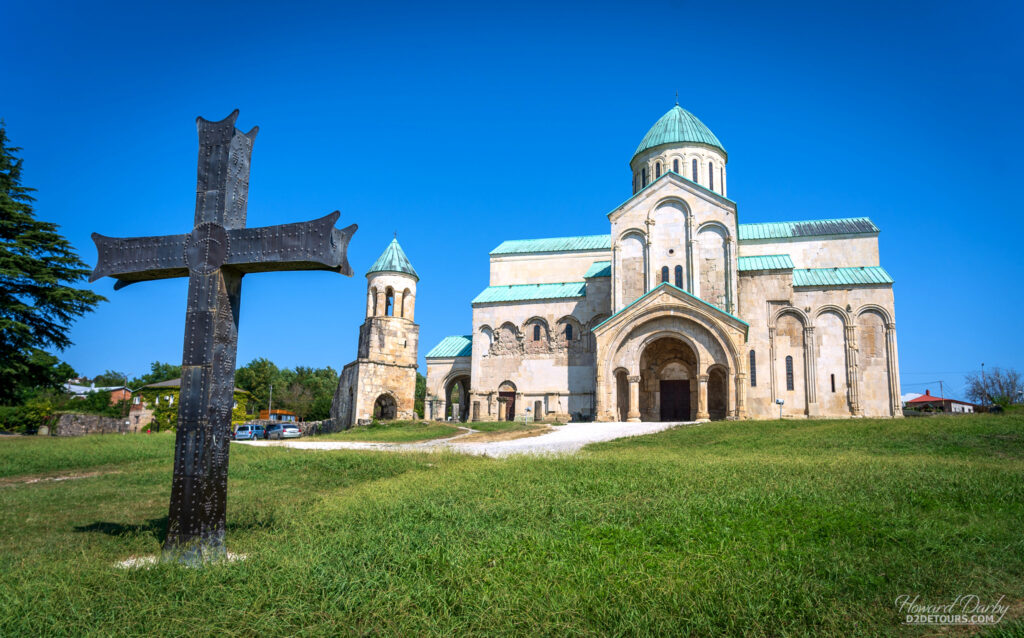
No controversy surrounds any of the restoration work undertaken on the picturesque Motsameta Monastery situated on a promontory overlooking the Tskaltsietela River. In the early 11th century, the Motsameta (meaning martyr) Church was built on the foundations of a much older chapel, and named in honour of two brothers, both of whom are buried in the monastery, who died leading a rebellion against Arab occupiers in the 8th century.
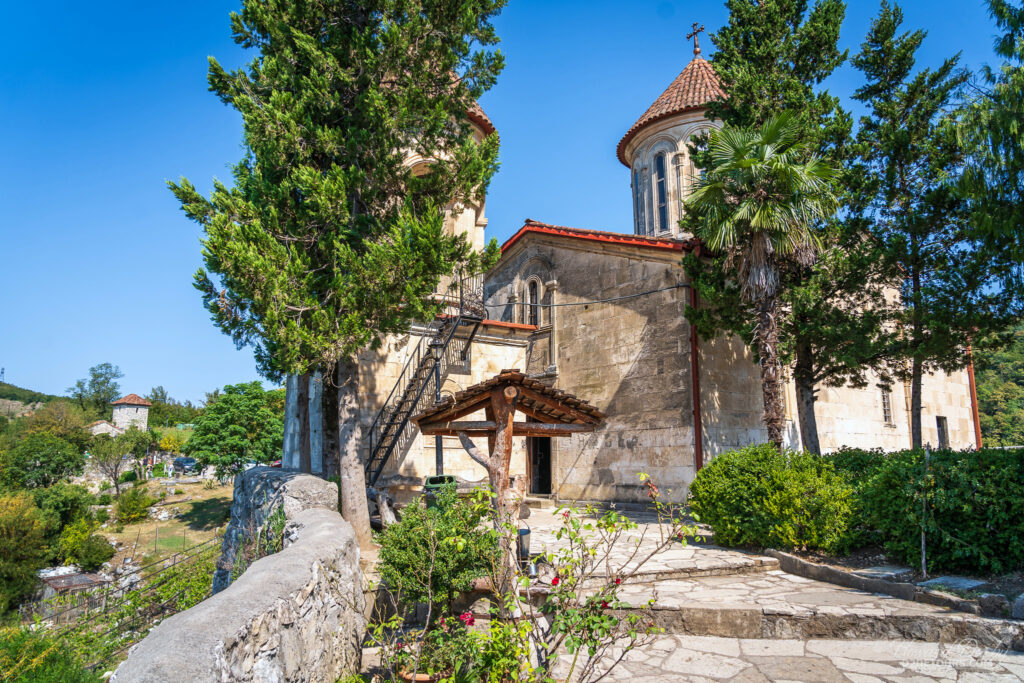
About 15 kilometres / 9 miles northwest of Kutaisi is the town of Tskaltubo (skow-tuba), which translates to “place of warm water.” The unique radon-carbon-rich natural springs in this region bubble out of the ground at the optimal bathing temperature of 35°C / 95°F, and have always been known for their restorative powers. The Russians, however, took the concept of balneology (the study of medicinal springs and the therapeutic effects of bathing in them) to a new level. One of the conditions contained in the labour code introduced by the Soviet government in the 1920s, was a guarantee that all workers receive at least two weeks of annual leave. Workers were strongly encouraged to enjoy this leave, often fully funded by their union, at a resort sanatorium where worker productivity could be “bolstered through the collective sharing of therapeutic treatments.” At one time 22 sanatoriums encircled a massive park in the center of Tskaltubo. Today only a handful are still in operation, the rest having been abandoned 30-odd years ago. Still, despite the level of decay you get a sense of the grandeur and elegance that once existed within the walls. We visited two sanatoriums in Tskaltubo, Imereti built in 1961 and Medea completed in 1962.
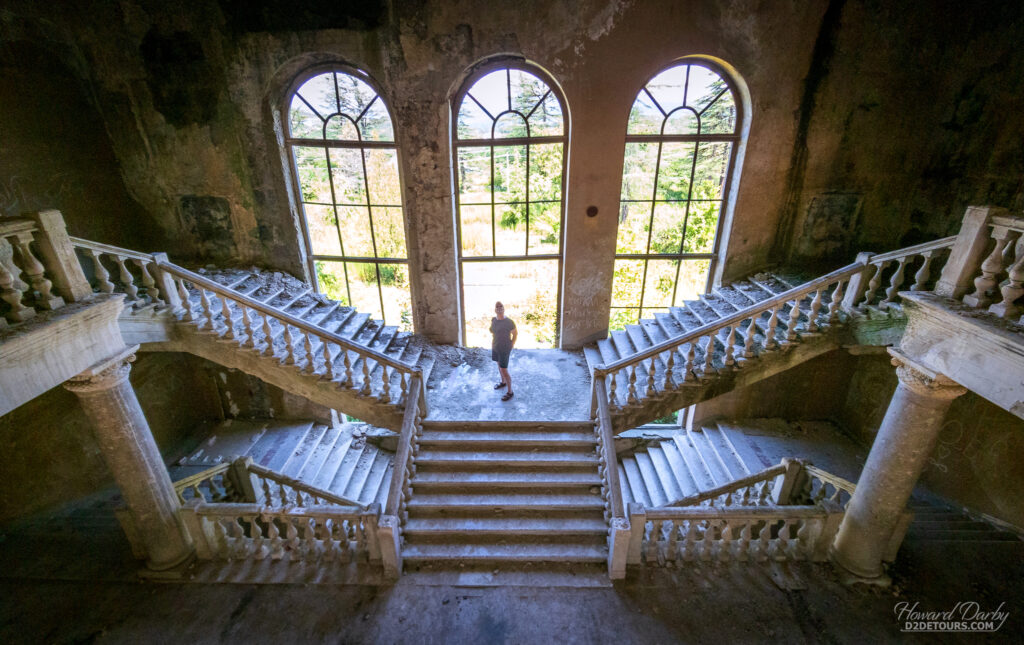
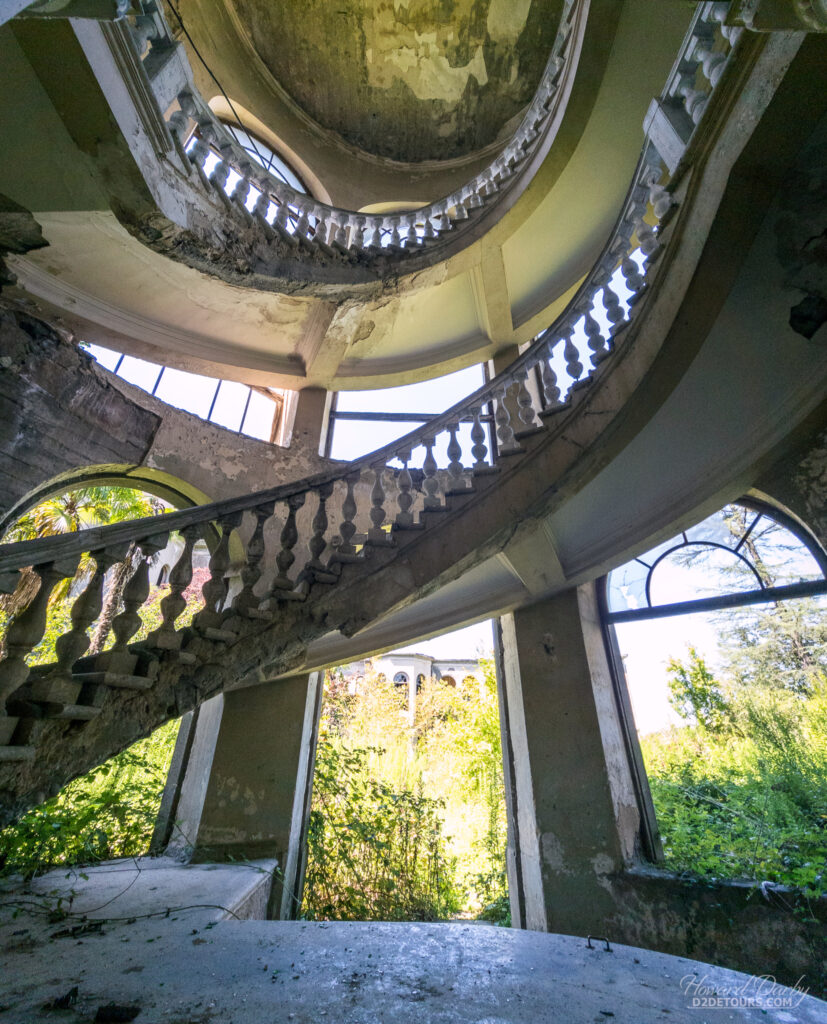
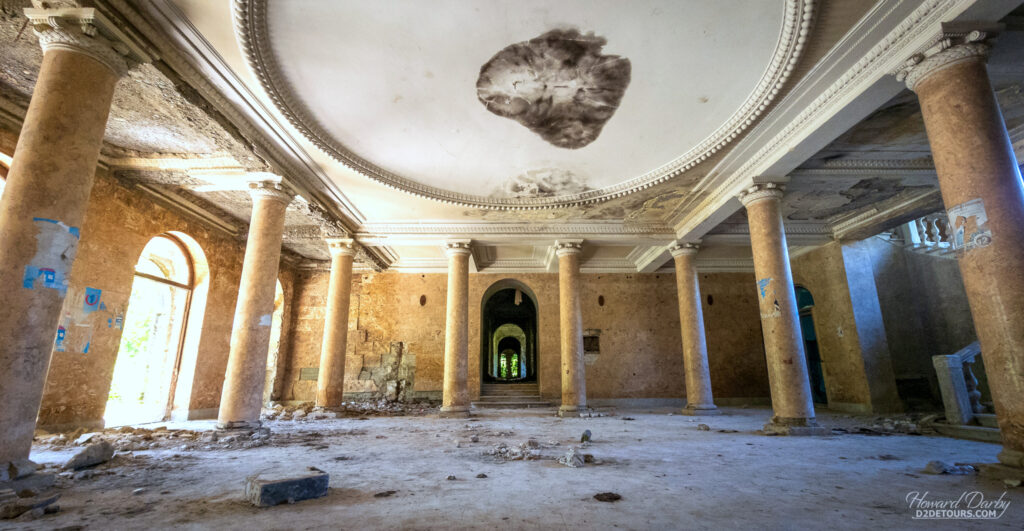
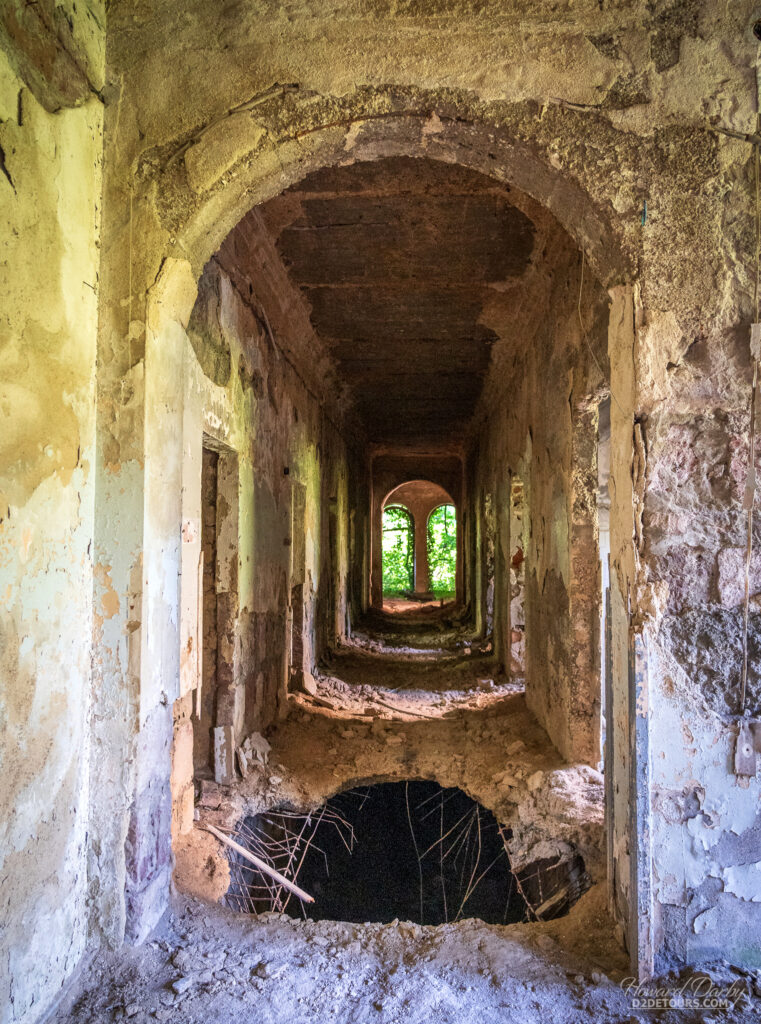
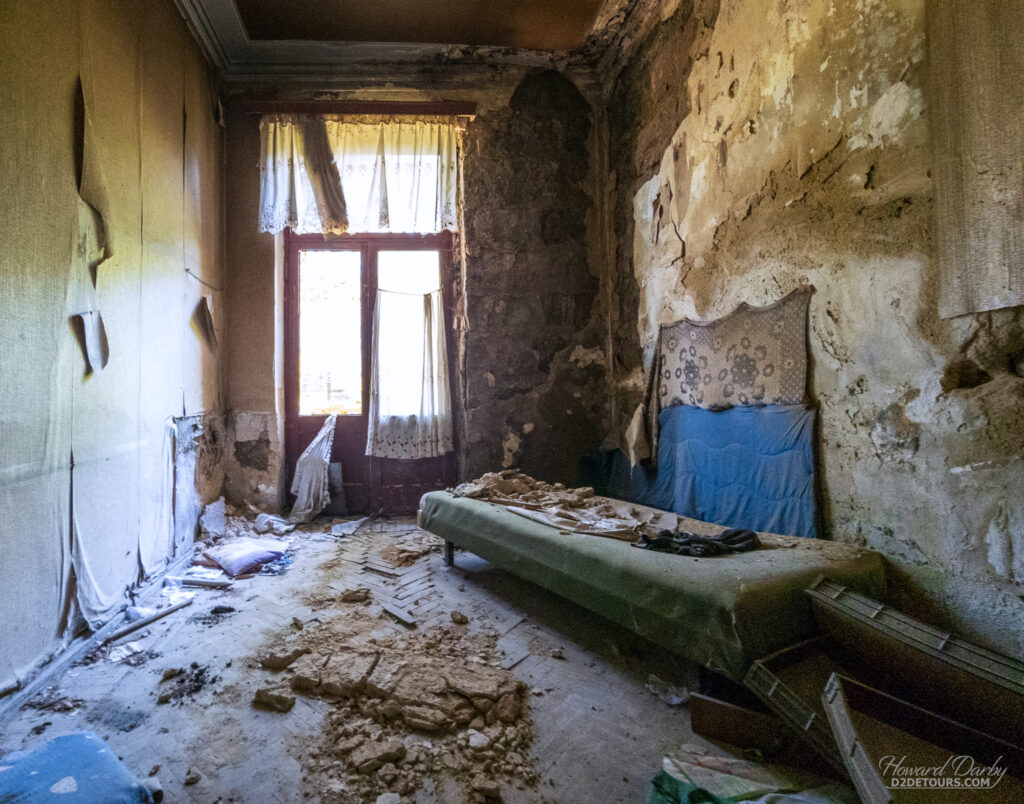

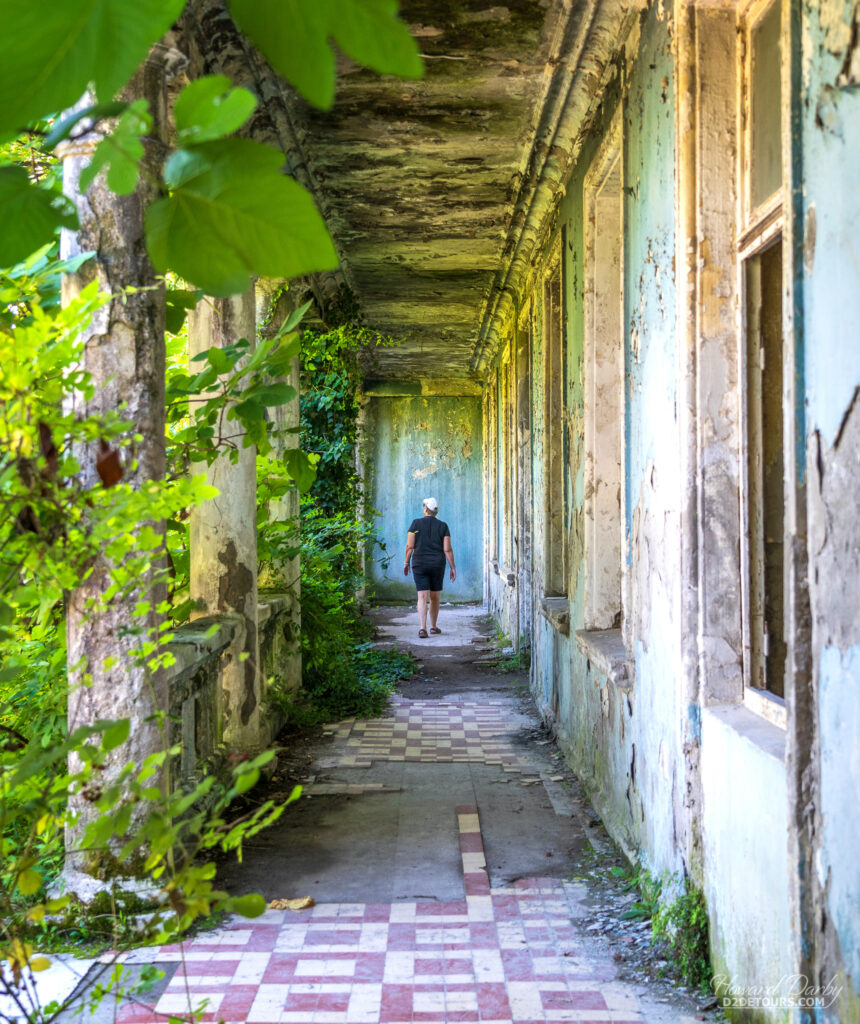
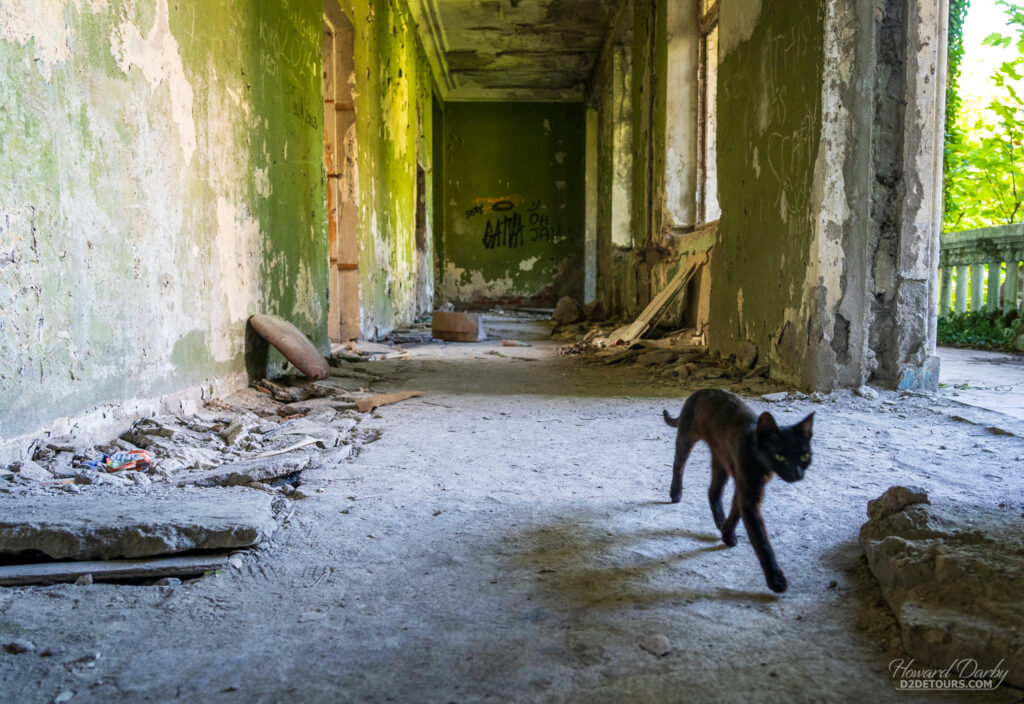

The Menji Sanatorium, circa 1930s, is in the town of Senaki about an hour and a half west of Kutaisi and while people are no longer enjoying its comforts, the cows seemed pretty content inside.
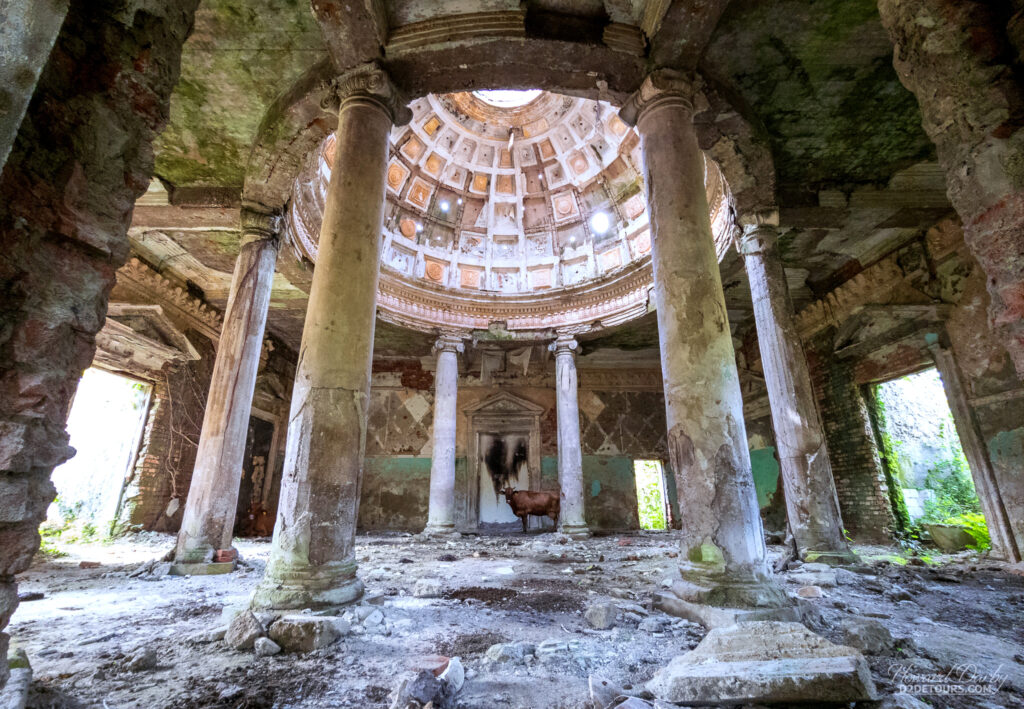

The worst road conditions we have ever encountered were on the drive up to Mestia in the Caucasus Mountain range. Chunks of the narrow road hugging the mountainside had slid down into the valley below, leaving cars to take turns (frequently without the aid of a flagman!) crossing the remaining 10-15 m / 32-50 ft portion of roadway. Other sections of the road were an unsurfaced mess of loose gravel and huge rocks that threatened to tear a strip from our undercarriage.
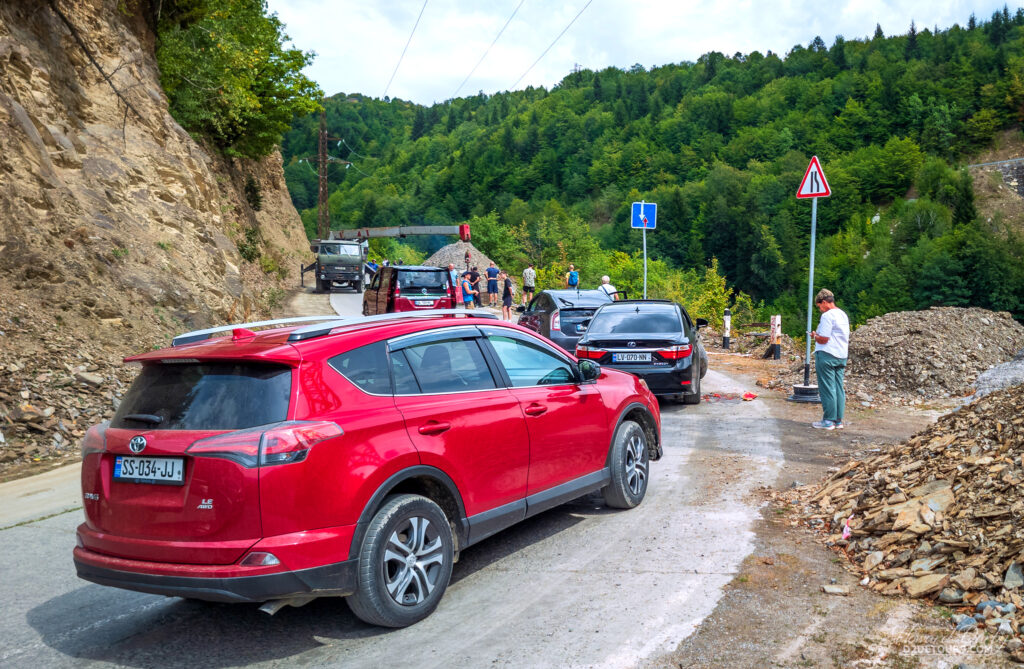
What draws most tourists to this part of Georgia, in addition to the stunning scenery, are the 9th to 12th century Svan Towers, defensive structures unique to the region. These towers are either freestanding or attached to several connected residences, with the lowest two floors providing living quarters for both people and livestock. The top floors (typically 3-5 stories), and only accessible with an internal ladder, were used exclusively for defense with the uppermost floor surrounded by a parapet for cover when launching projectiles. Now, you might assume these towers were the first line of defense against foreign invaders, but you’d be mistaken. The Svans are an ethnic subgroup within Georgia, having been isolated for generations in the mountains thousands of feet above sea level. Traditionally, these mountain settlements were more like family estates, and retreating to their towers was in response to a threat from a neighbouring clan. Mestia, with an elevation of only 1,500 meters / 4,921 feet, is the most accessible townlet in the Svaneti region, and boasts a population of nearly 2,000 residents. Multiple towers fill its skyline but it is also full of hotels, hostels, and restaurants detracting from its old-world charm.
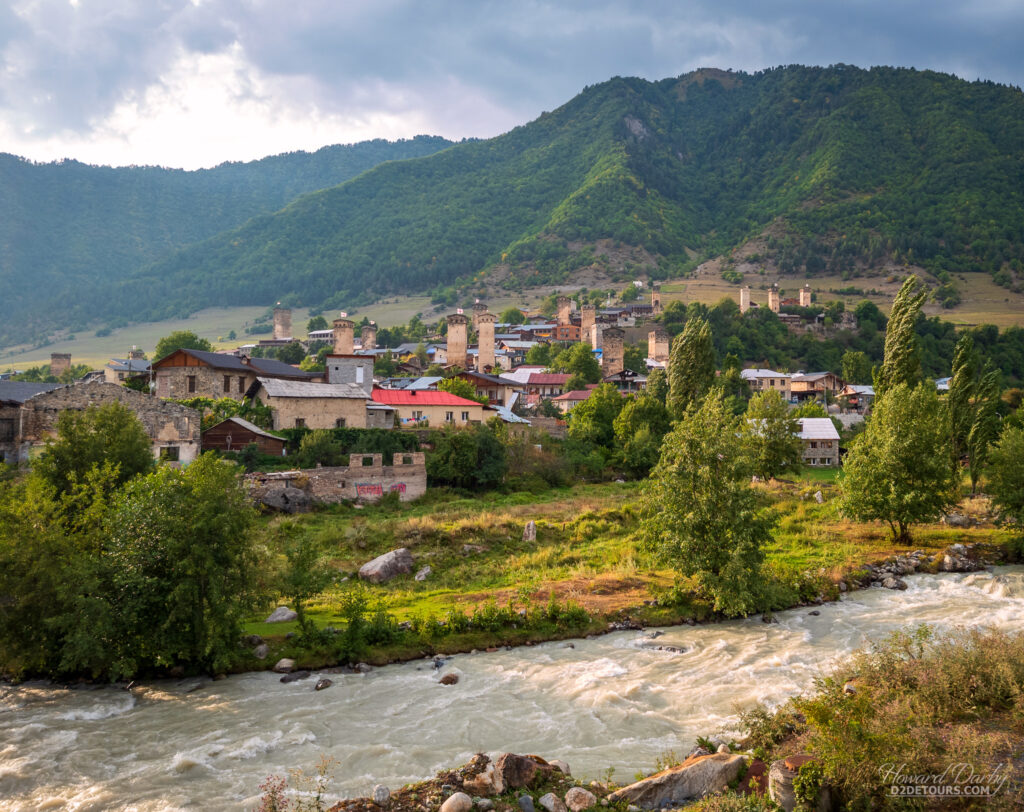

Ushguli, at an altitude of 2,100 meters / 6,900 feet, is 47 kilometres / 30 miles from Mestia, and where tourists go to get a more authentic experience. Our rental car contract prohibited us from driving past Mestia. The Mestia/Ushguli road is a common exclusion for rental cars and the main street in Mestia was full of companies offering transport options. You could hire a private tour guide, grab a taxi, or book a seat on a small bus. We opted for the bus and paid $25 CAD/pp for a seven-hour adventure – 1.5-hour drive to/from Ushguli, and four hours to explore the village. After surviving the road to Mestia, we couldn’t begin to imagine what we would encounter on the road to Ushguli. Turns out that other than one section where a recent landslide had caused havoc, the road was totally driveable and we figured the rental car exclusion had more to do with the inability to access roadside assistance than with the road conditions. Ushguli is very primitive and well worth a visit.
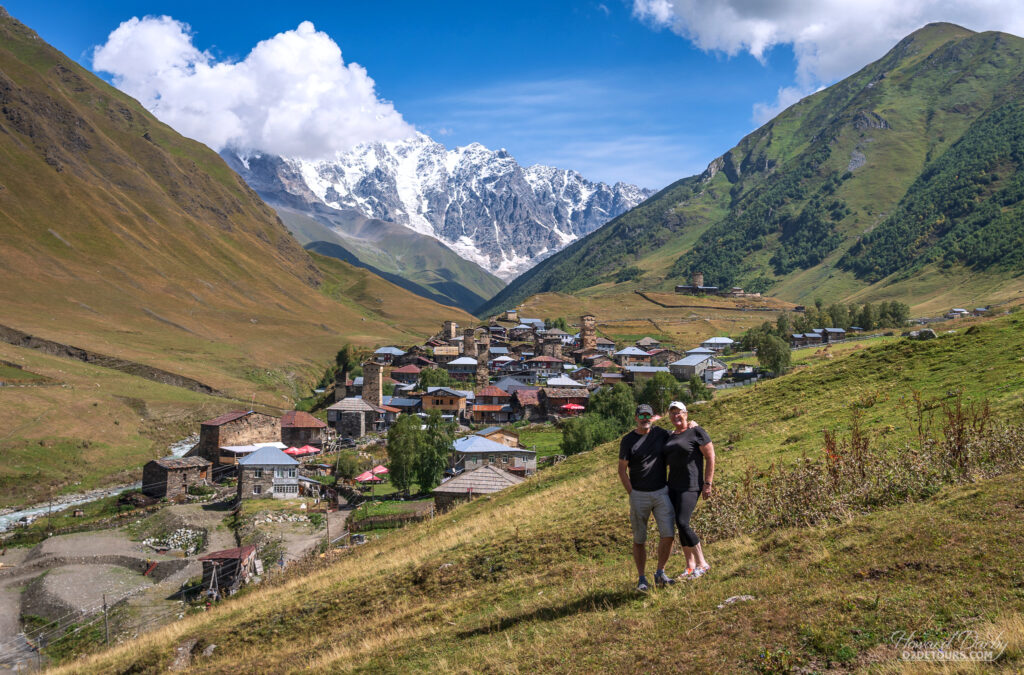
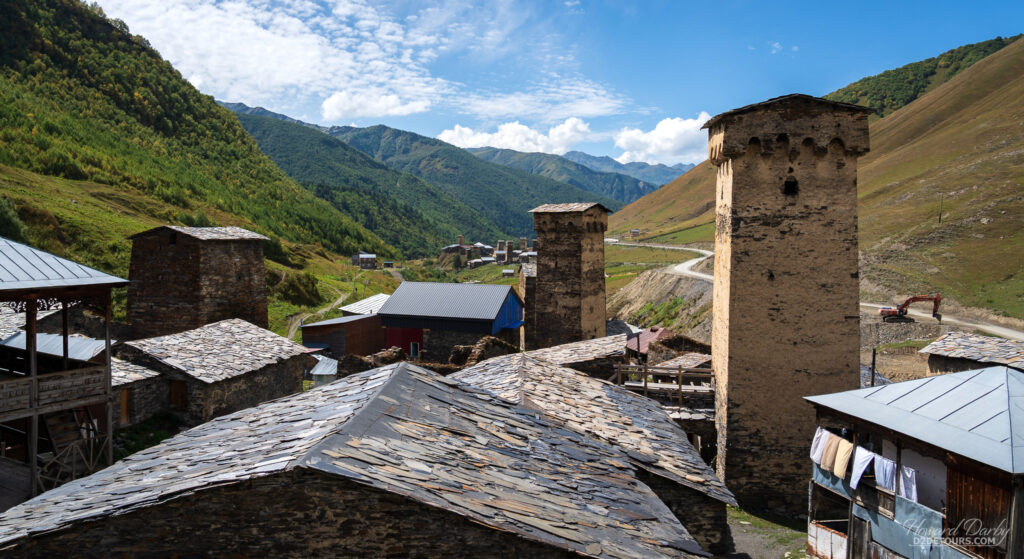
We had planned on finishing our road tour of Georgia in the south-central region of Vardzia, only to have car trouble take us back to Tbilisi. We made the best of that detour and visited a couple of monasteries in Mtskheta, an ancient city that had been the capital of the Kingdom of Iberia. Located about 40 minutes north of Tbilisi, the 6th-century Jvari Monastery is a rare example of a Georgian Orthodox church that has survived the centuries virtually unchanged, although ground erosion is now posing a significant threat. The Jvari Monastery is generally accepted to have been built on the site where a female missionary, who is now one of the most venerated saints in the Georgian Orthodoxy Church (Saint Nino), converted the last pagan king to Christianity.
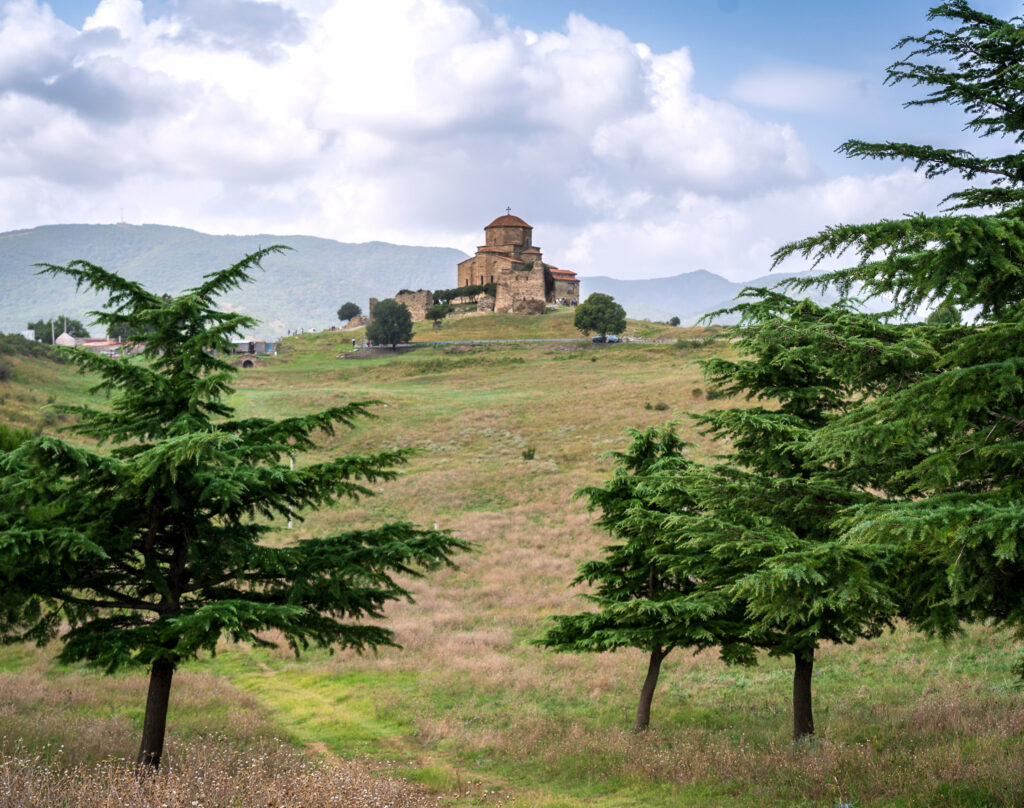
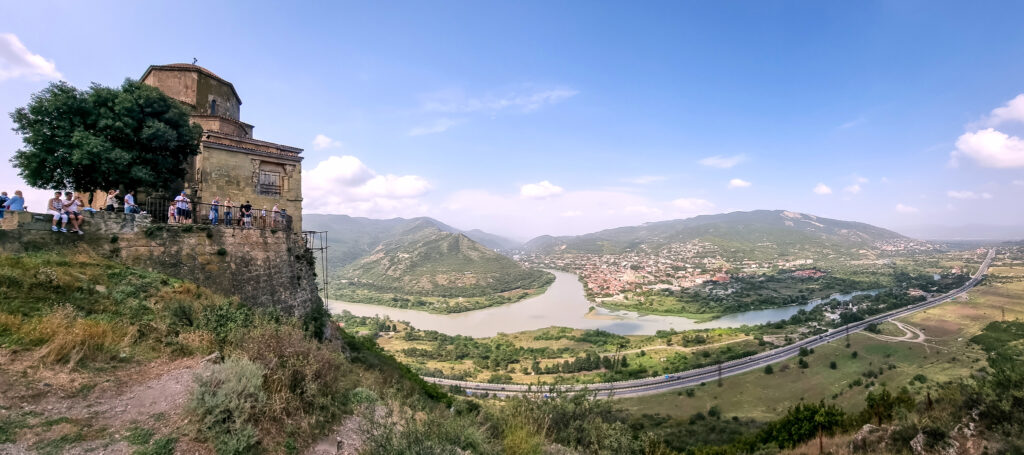
Below Jvari Monastery, in the town of Mtskheta, is the Svetitskhoveli (svet-ix-ovlis) Cathedral, the largest church built during Georgia’s “Golden Age” (11th-13th century) to have survived to the present day. Though the interior suffered significant damage as a result of whitewashing by Russian authorities in the 18th century (notwithstanding the fact that Russian Orthodoxy and Georgian Orthodoxy are both branches of the Eastern Orthodox Church), portions of the striking frescoes are still evident.

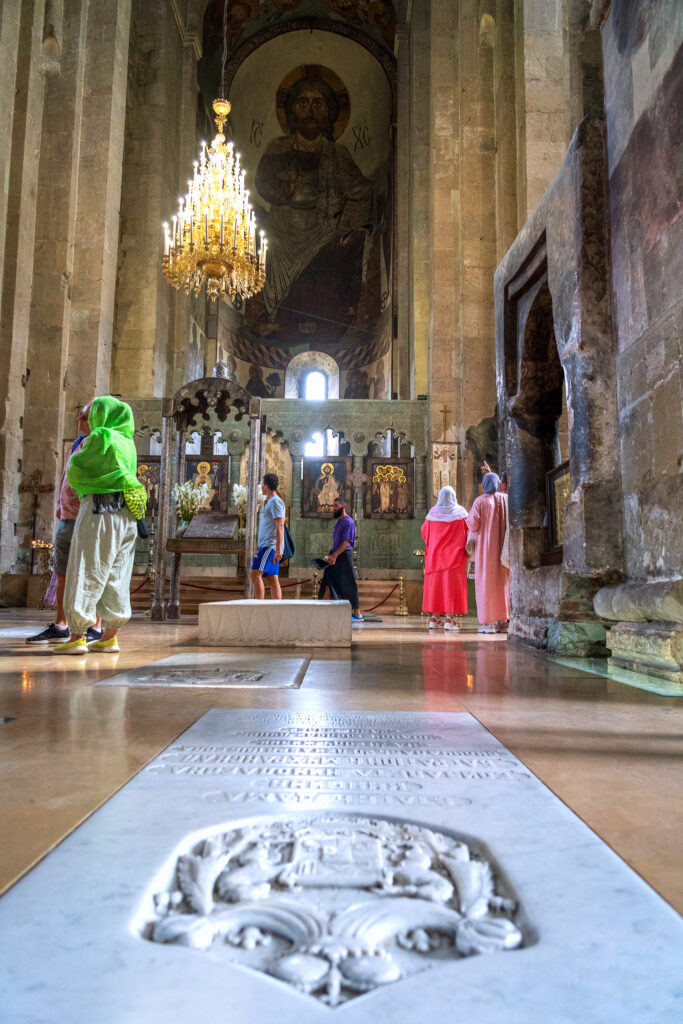
Us – Despite some challenging road conditions, and a bit of a sense of lawlessness, we’ve loved everything about Georgia. The countryside is a gorgeous collection of rolling hills and mountains, the people are kind, the food is fantastic, and the history compelling. We would return. Now to explore Tbilisi on foot!
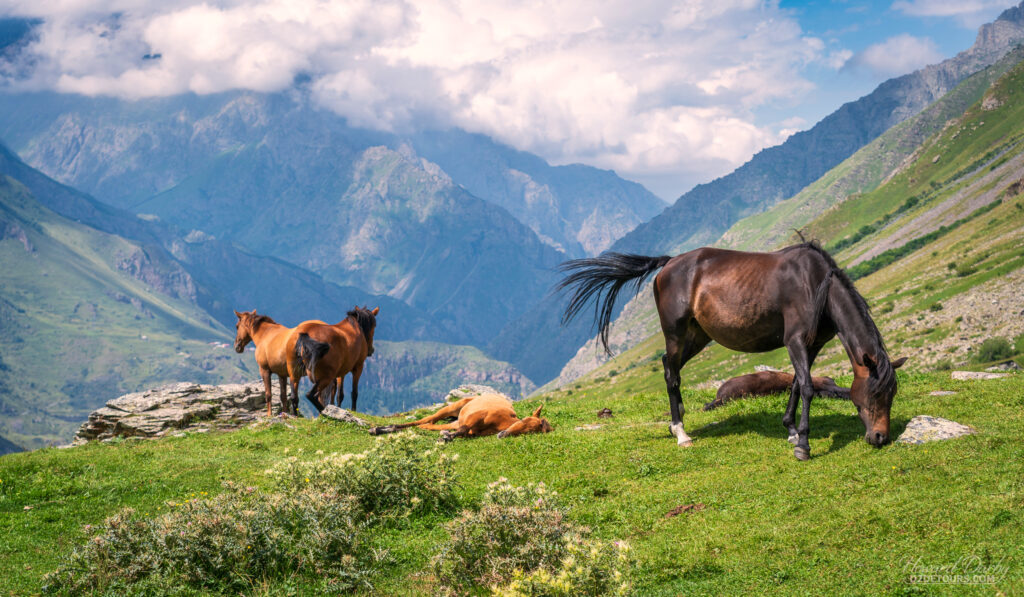
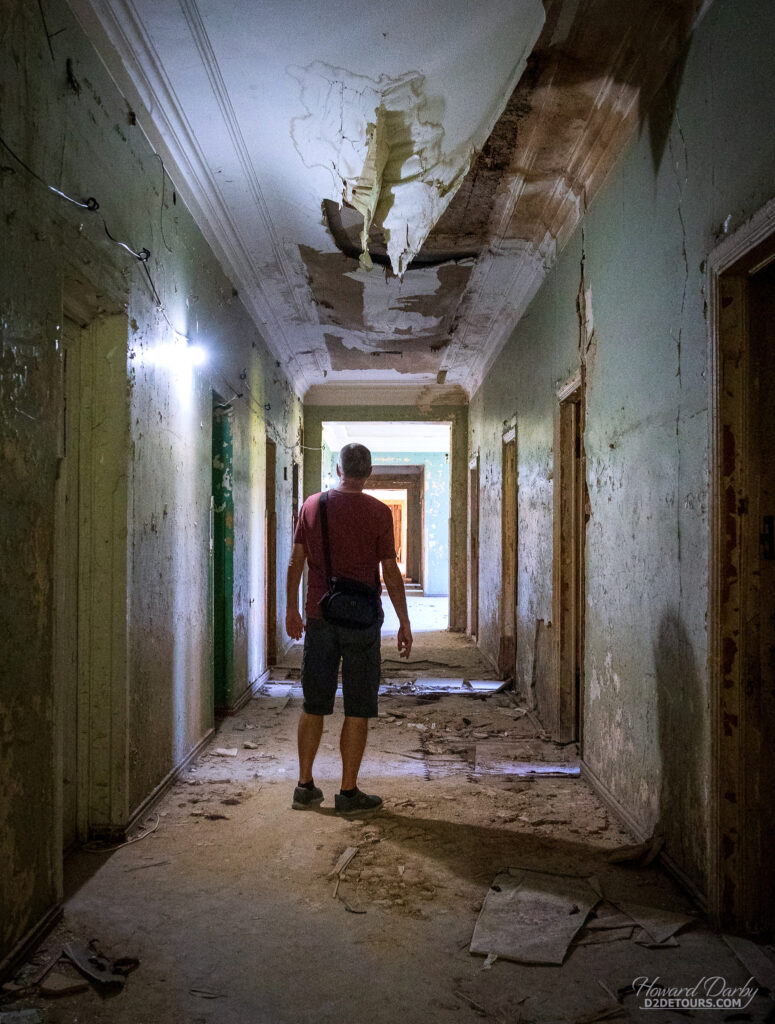
Restaurants – All of our restaurant choices were casual eateries, where food is served family-style (a platter of food rather than being individually plated) and none of them were disappointing. The traditional tomato, cucumber, onion, and walnut pesto salad was consistently delicious, and when the dish description includes the word “cream” I’m hooked. Shkmeruli (chicken in a creamy garlic sauce), with a side of Georgian bread to sop up the gravy was heavenly.
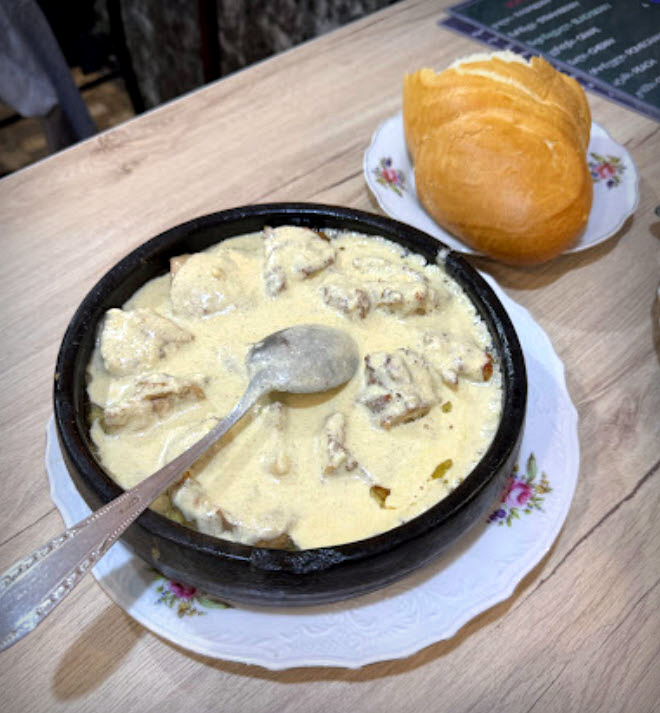
Two of our memorable meals were in Stepantsminda. The oddly named Lunch at Maia, which is only open for breakfast and dinner, seats its guests in the garden and serves hearty meals prepared by the family in their kitchen.
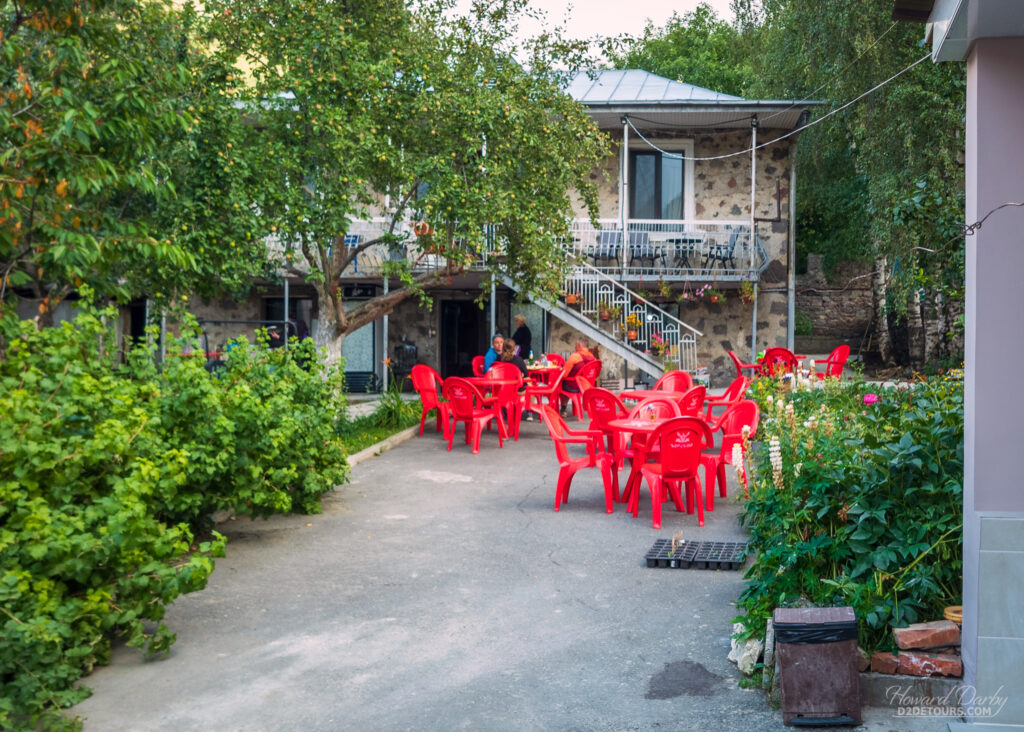
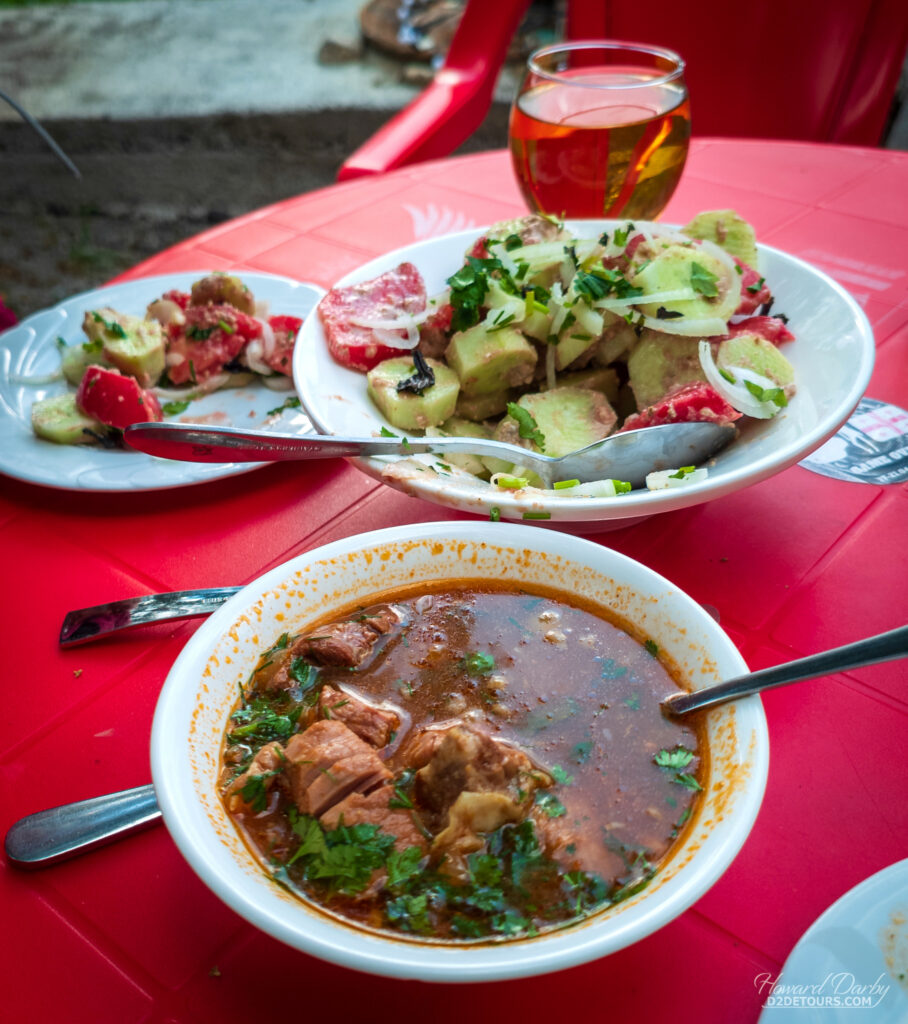
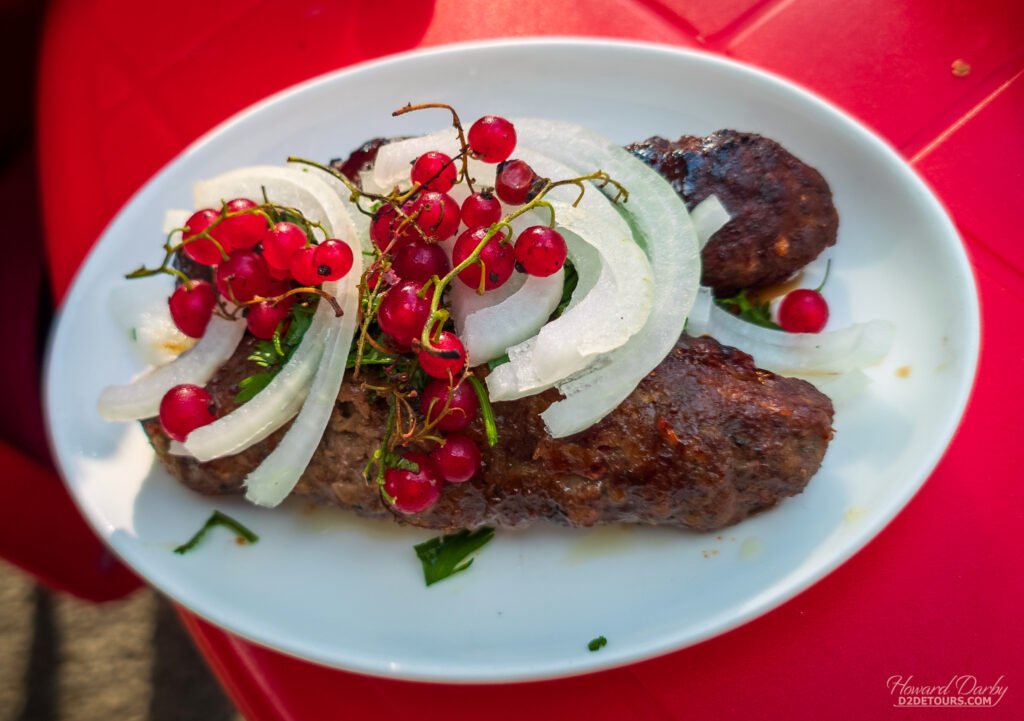
The second yummy meal in Stepantsminda was from Pizzeria Mila, a takeaway joint (zero seating). I had never before discovered disposable gloves in the bag alongside my burger and fries; after a few juicy bites left my hands dripping with the delectable sauces I understood the need.

Speech – This has nothing to do with language, but I like trivia almost as much as I like history, so I share the following with you … In the eighteenth century, racial classification, as proposed by the German anatomist Johann Blumenback, became the widely accepted method for categorizing the human species. After a visit to the Caucasus Mountains in Georgia, Blumenback claimed that Adam and Eve were the original inhabitants of that region and thus were Caucasians. He theorized that all other races were simply a “degeneration” from the Caucasian race, the result of environmental factors like the sun or poor diet. The seed for this leap in logic, in addition to deep-seated Christian values, may have sprung from a series of acclaimed travel logs published decades earlier that described the Georgian people as the “most beautiful humans in the world.”
And here’s a few Georgian words to properly complete this post:
- Gamarjoba (ga-mar-jo-ba) – Hello;
- Nakhvamdis (na-khvam-dis) – Goodbye;
- Tu Sheidzleba (tu she-id-zle-ba) – Please;
- Madloba (mad-lo-ba) – Thank You;
- Arapris (ara-pris) – You are Welcome;
- Ki / Ara (ki / ara) – Yes / No;
- Ver Gavige (ver ga-vi-ge) – I Don’t Understand;
- Ukatsravad (u-kats-ra-vad) – Excuse Me/Sorry.

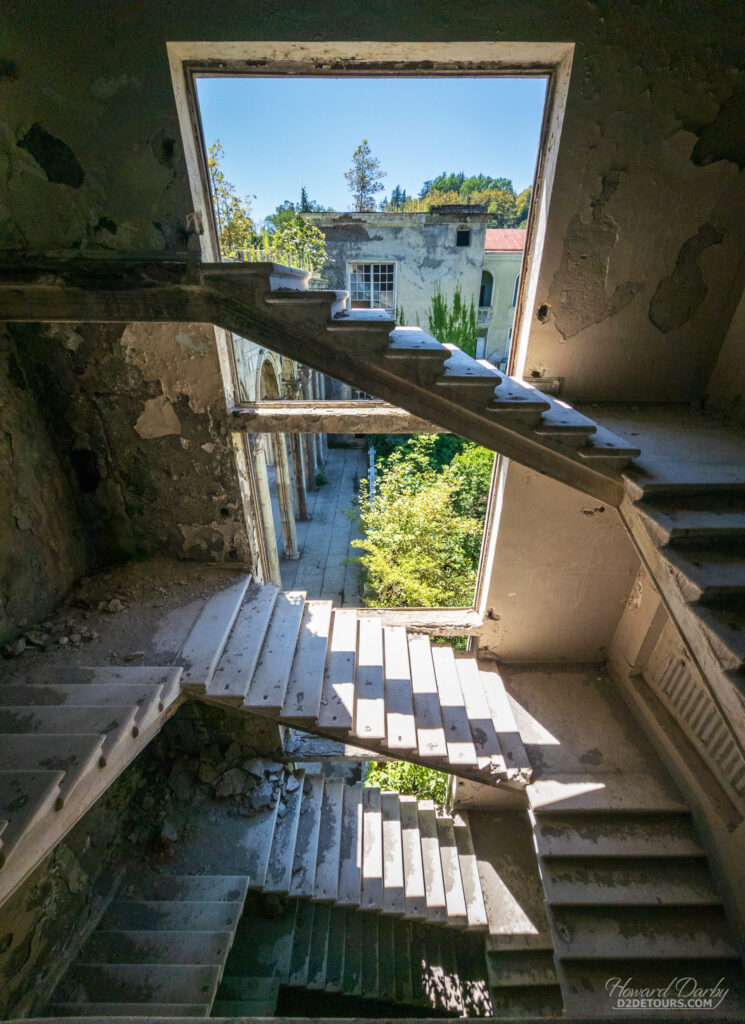
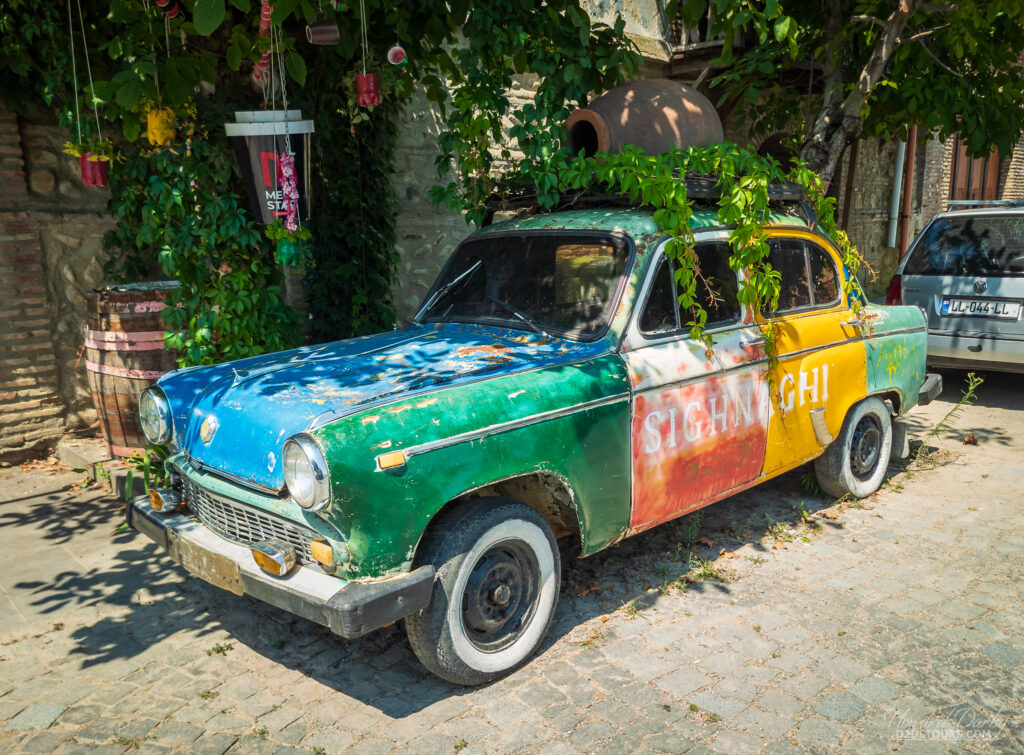
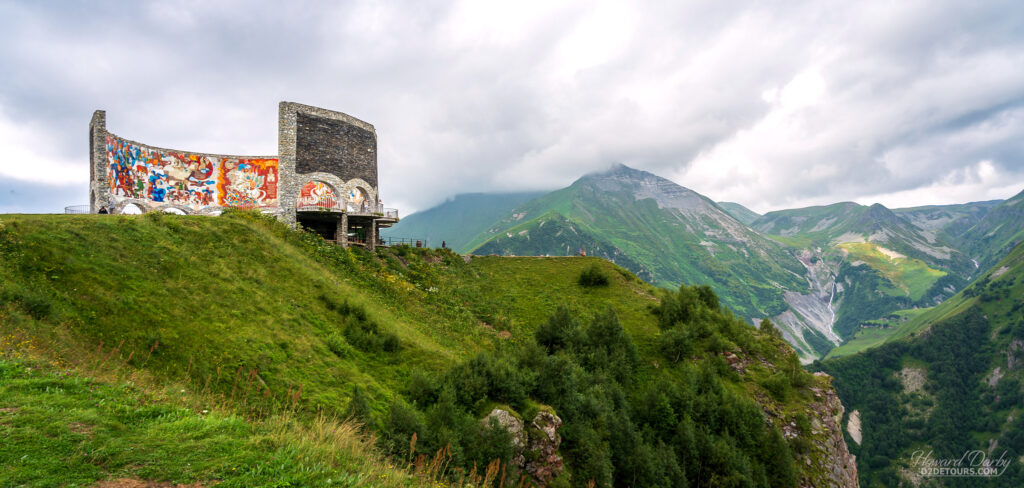

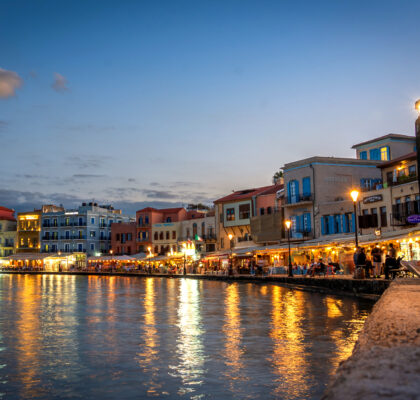
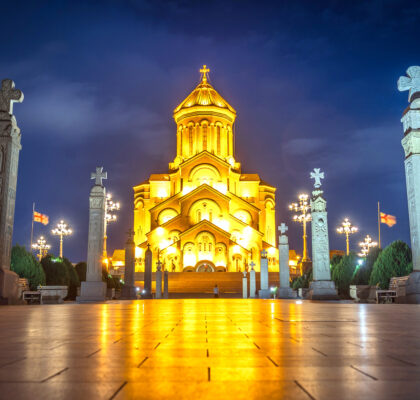
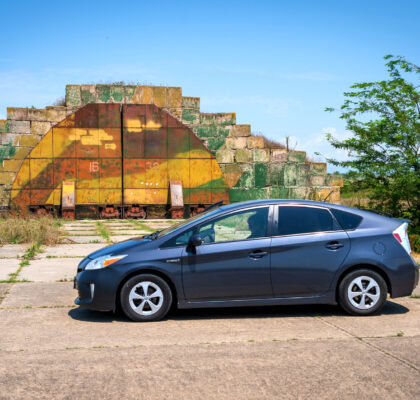
Very inspiring- thank you
Pingback: Crete: Exploring The Largest Greek Island - D2 Detours
Pingback: Howard's Favourite Photos From 2024 - D2 Detours
Pingback: Abandoned Places: They're Some of our Favorite Travel Spots! - D2 Detours